| |
Rick Archer's Note:
If you would like to read the
story of how a Lowly Servant Bedded a Queen and
started a Dynasty, there are two places to begin.
The place I recommend you
start is with 'The Madness
of King Charles'.
Or you can go straight to the
juicy stuff and visit 'How
a Lowly Welshman Bedded a Queen and Sired A Dynasty'.
However, I don't recommend the
shortcut. This story is so complicated that
you really do need the background information in
order to follow the bouncing ball.
|
| |

The War of the Roses
ACT THREE:
Richard III
|
| |
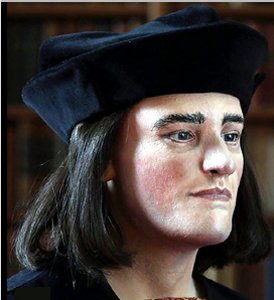 |
The star
of Third Act in the War of the Roses is none other
than Richard III. And who might be Richard the
Third? We know
Richard better as Edward IV's younger brother
Richard, the Duke of Gloucester.
Richard
the Third made a lot of enemies, but his worst enemy
was William Shakespeare. William
Shakespeare had a field day at Richard's expense with
Richard III, considered one of The
Bard's ten
best plays.
Before
Shakespeare was finished, Richard had murdered Henry
VI, his brother George, his nephews, and even his
own wife during his well-plotted ascent to the
throne. In case these heinous murders were
insufficient clues, Shakespeare dressed Richard in
black and accentuated his a hunchback to emphasize
who the villain was.
|
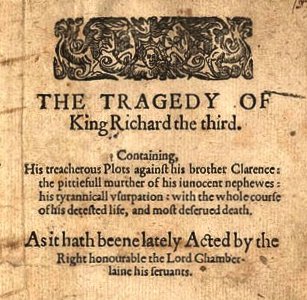 |
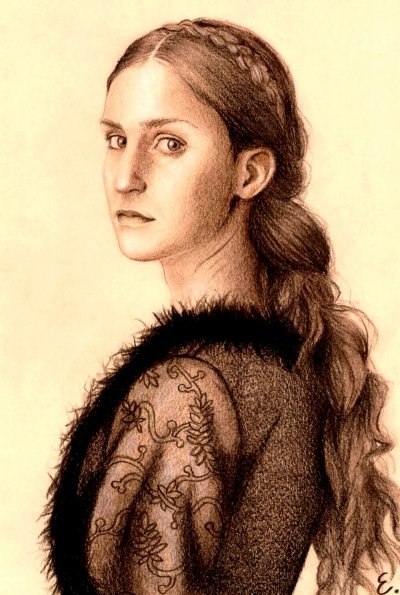 |
Anne Neville
Following Prince Edward's death at Tewkesbury, his
wife Anne Neville became the grand prize.
Anne
Neville was born into the wealthiest and most
politically powerful family in the kingdom. Youngest
daughter of the Earl of Warwick, Anne watched her
father make a king out of Edward of the House of
York, and then change his alliance to the House of
Lancaster. Anne, raised a York, was expected
to change her loyalties as well.
In 1470, Anne had been the trophy dangled by her
father Warwick to secure the backing of Margaret of
Anjou in the newest attempt to overthrow King Edward
IV. During the desperate race to reach Wales,
Anne chose to stay with the army. She marched
with them for more than a hundred miles, from
Weymouth to Tewkesbury where Edward’s pursuing army
caught them, killing Prince Edward and capturing
Margaret of Anjou.
Anne was a widow at 15, far too wealthy and powerful
to be left to chance. Her sister Isabel, now a loyal
supporter of the House of York thanks her
side-switching
husband George, scooped up the girl and took her
into their keeping. Isabel swore she was
protecting Anne, but in reality this was more likely a form of
house arrest.
Anne became the subject of
dispute between George, Duke
of Clarence, and his brother Richard,
Duke of Gloucester, who
had stated to George his desire to marry her.
Anne and her sister
Isabel, George's wife, were heiresses to
their parents' vast estates. George
was anxious to secure the
combined inheritance of
both sisters! George thereby treated
Anne as his ward and
opposed her getting married.
Strange stories ensued. One wild tale had
George hiding Anne in a London
diner, disguised as a
servant, so that his brother would not know where
she was.
Nonetheless, Richard
Gloucester tracked her down
and escorted her for safekeeping
at the Church of St Martin le Grand
out of George's reach. In order to win
the final consent of his brother George to the
marriage, Richard renounced most of Warwick’s land
and property, including the earldoms of Warwick
(which the earl had held in his wife’s right) and
Salisbury and surrendered to
George the office of Great Chamberlain of
England. It was a high
price to pay.
|
In this
passage from The Kingmaker's Daughter,
Anne Neville is talking to herself shortly after the
fall of Tewkesbury:
One of the
guards
has stumbled while mounting his horse.
Frightened, his horse shies
away, knocking the horseman
to the ground. Seeing
the horse rear, King Edward puts his arm
around his wife in an unconscious
gesture to protect her. Everyone
is looking that way.
I snatch off my glove
and, in one swift gesture, I throw it towards
Richard. He catches
it out of the air and tucks it in the breast of his
jacket. Nobody has
seen it. Nobody
knows.
The guardsman steadies
his horse, mounts it, and
nods his apology to his captain.
The royal family turns
and waves to us.
Richard looks at me,
buttoning the front of his jacket, and smiles at me
warmly, assuredly, to denote he
understands the meaning of my gesture.
Richard
has my glove, my favor. It is a pledge that I
have given in the full knowledge of what I am doing.
Because I
never want
to be anybody’s pawn again.
Philippa Gregory, The
Kingmaker's Daughter
|
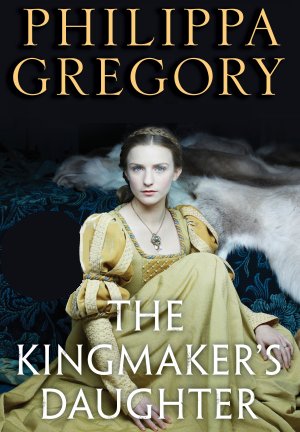 |
| |
|
The Strange Saga
of George
So what
exactly did Shakespeare mean by the immortal line 'false,
fleeting, perjur'd Clarence, that
stabbed me in the field by Tewksbury!'
Shakespeare was referring to the ghost of Edward,
Prince of Wales, stabbed to death in cold blood
following the Battle of Tewkesbury.
George, better known as 'Clarence',
is dreaming of
the evils he has
done
during his fitful sleep preceding
his imminent execution.
|
|
|
|
Following Warwick's death in
the 1471
Battle of Barnet, George, Duke of
Clarence, was consumed by
a serious overdose of greed. Married to
Isabel, one of Warwick's two daughters, George went
ahead and confiscated the vast estates of the
earl. George had been be a
very bad boy. He
had betrayed his brother Edward. Later
he betrayed Warwick, his father-in-law. In
George's case, cheating had been profitable.
In March 1472 by right of
his wife Isabel, George became the
Earl of Warwick and Salisbury.
George was now rich beyond his wildest imagination.
Nevertheless, he was greatly disturbed when
he heard that his younger brother Richard was
seeking to marry Warwick's younger daughter Anne,
Isabel's sister.
George was upset because Richard was
also claiming some part of Warwick's lands
as part of the wedding package.
George refused to part with
a single nickle, so a violent quarrel
between the brothers ensued.
After George failed to prevent
Richard from
marrying Anne, the quarrel grew
worse. Finally, in 1474
King Edward had to step in to
settle the dispute, dividing the estates between his
brothers. [It must be tough
being rich, but then I wouldn't know.]
In
December 1476, George's wife Isabel
died two months after
giving birth to a short-lived son named Richard.
Though Isabel's death was likely the result of
either consumption or childbed fever, George was
convinced she had been poisoned by Ankarette, one of
her ladies-in-waiting, operating in cahoots with his
enemy Elizabeth Woodville. George alleged that
King Edward’s wife was guilty of
witchcraft in this matter. Try to imagine how
well that sat with King Edward.
George bullied a
jury into convicting Ankarette of murder by
poisoning, then had her hanged immediately after
trial. Clarence's mental state, never stable
to begin with,
deteriorated from that point on.
|
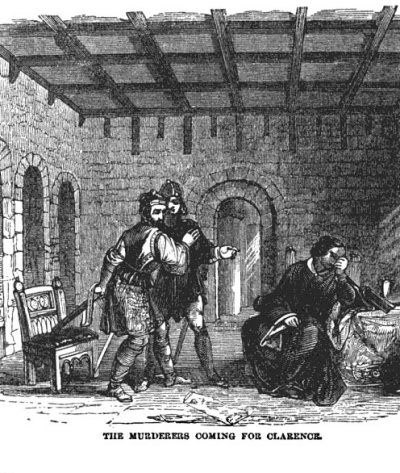 |
In 1477
George
became a
suitor for the hand of
Mary,
daughter of Charles the
Bold. Mary was
quite the catch, being
extremely beautiful and
possessing vast estates.
She was better known by
her nickname,
'Mary the Rich'.
George wanted to marry
the rich.
Unfortunately for
George, King
Edward
objected to the match.
Clarence,
assuming his jealous
brother Richard was
behind this slight,
left the court
fuming.
George was not getting
along with Edward well
at all. In
addition to
belligerently accusing
Edward's wife of
murdering Isabel, not
long after her death of
Isabel, men
who were in the employ
of George were caught
plotting against the
King. The timing
was very unfortunate.
It seemed like George
was trying to get
revenge of some sort.
There's an old saying, 'Once
a cheater, always a
cheater'.
George had crossed the
line one time too many.
Edward had forgiven the
man once before; he wasn't
going to make that
mistake again.
Edward had the
duke thrown into prison,
then
unfolded the
charges
to the
parliament...
George had
slandered the king; had
received oaths of
allegiance to himself;
and
was
preparing for a new
rebellion.
In short, George was
bad.
George was executed 'in
private'.
In his play, Shakespeare
gave Richard the blame,
but history suggests
Richard had nothing to
do with it.
Following George's
death, there
was a strong
rumor that
George had been
drowned in a
cask
of malmsey wine.
The headsman does
it, leaving his axe to
one side but wearing
his black mask over his
face. He is a big man
with strong big
hands and he takes his
apprentice with him.
The
two of them roll
a barrel of malmsey wine
into George’s room and
George the fool makes a
joke of it and laughs
with his mouth open wide
as if already gasping
for air, as his face
bleaches white with
fear.
Philippa Gregory, The
White Queen
|
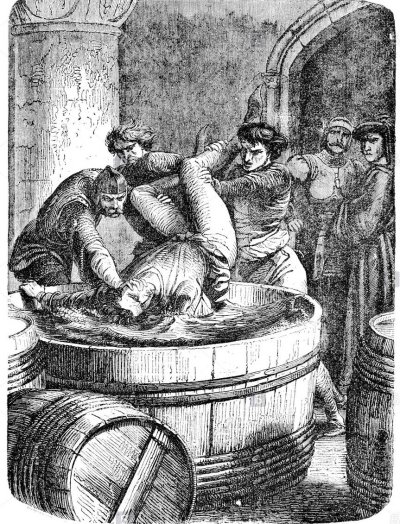 |
Long Live the
King... or maybe not
Following Tewkesbury, there were twelve years of
peace in the land. With the Lancastrian
line virtually extinguished, Edward faced
no more rebellions after his restoration.
Edward and
his wife Elizabeth had been through a lot.
Amazingly, Elizabeth had kept the children safe
while Edward was constantly fighting to keep his
throne or regain his throne. Three of his
children would figure prominently in Act Three.
•
Elizabeth
of York (1406-1503)
•
Mary
of York (1467-1482)
•
Cecily
of York (1469 – 1507)
•
Edward
V of England (1470 – 1483)
•
Margaret
of York (10 April 1472 – 11 December 1472).
•
Richard
of Shrewsbury
(1473 – 1483)
•
Anne
of York (1475 – 1511)
•
George
Plantagenet (1477 – 1479).
•
Catherine
of York (1479 – 1527)
•
Bridget
of York (1480 – 1517)
Tragically, Edward died
unexpectedly after a short illness on 9 April 1483.
Everyone was in shock.
There
would never have been an Act III to the War of the
Roses if Edward had reigned just a bit longer.
Unfortunately, Edward's untimely death in 1483 would
reignite the War of the Roses. In the
picture, dark-haired Richard stands at King Edward's
side. How fitting that Richard III would
become the villain of Act III.
|
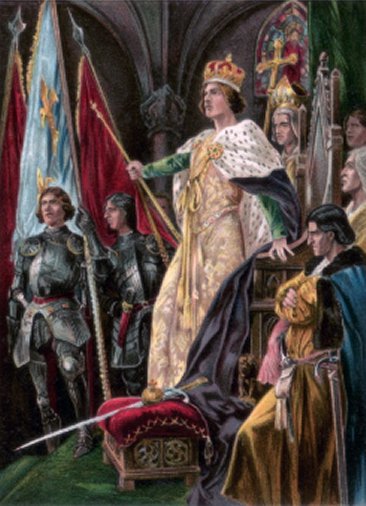 |
 |
Richard's
Treachery
When
King Edward's health began to fail,
at least he had sufficient time to put his affairs
in order. Edward was comforted by the
knowledge that the ever-present issue of succession
was not a problem. Elizabeth had given birth
to two healthy, handsome, well-educated boys,
Edward, 12, and Richard, 10.
Edward
smartly named Richard, his trusted brother, as
protector of his two sons. On second thought,
maybe not so smart.
On the
death of Edward IV, on 9 April 1483, his
twelve-year-old son, Edward V, succeeded him while
Richard, the current Duke of Gloucester, was named Lord Protector of the Realm.
Richard moved swiftly and secretly to prevent the
Dowager Queen Elizabeth from exercising power.
Richard
left his base in Yorkshire for London. On 29
April, as previously agreed, Richard was joined on
the route by his cousin the Duke of Buckingham.
They met Anthony Woodville, the Dowager Queen
Elizabeth's brother at Northampton.
Anthony
Woodville was escorting young Edward at the Queen's
request to London with an armed escort of 2000 men.
Richard and Buckingham's joint escort was of 600
men. The
young king was not there. He had been sent further south to
Stony Stratford.
Richard
politely invited Anthony Woodville, his nephew
Richard Grey (son of Elizabeth by a prior marriage),
and Thomas Vaughan to dinner. After the meal,
they were suddenly arrested on the charge of treason
against the Lord Protector. On June 25, they
faced a tribunal led by Henry Percy, 4th Earl of
Northumberland. The three men were found
guilty and executed.
After having Lord Rivers (Woodville) arrested, the two dukes
moved to Stony Stratford where Richard falsely
informed the young king of a plot aimed at denying
him his role as Protector, adding that the 'perpetrators'
had been dealt with. Richard proceeded to
escort the young king to London on 4 May.
Richard
suggested to the boy that he would be the safest and
most comfortable in the Royal Apartments of the
Tower of London where kings customarily awaited
their coronation. The young Prince thought he
was a guest, but in reality he was a prisoner.
|
| |
Queen Elizabeth and
Lord Hastings
|
|
|
|
After
the unexpected death of Edward IV on 9 April 1483,
the dowager queen knew there could be trouble.
She sought to monopolize political power for her
family by appointing family members to key
positions. She also tried to circumvent
Richard, 31, Edward's younger brother, by rushing
the coronation of her young son Edward V, 12, as
king.
Lord
Hastings was probably the most loyal friend Edward
IV ever had. By all accounts, Hastings had
also been friendly with Richard. Conversely,
Lord Hastings was hostile to the Woodville family.
The Woodville family was not popular with many due
to their quest for wealth and power. Desiring
to frustrate the ambitions of the Woodvilles, Lord
Hastings turned to the new king's uncle - Richard,
Duke of Gloucester, brother of Edward IV.
Hastings
checked Elizabeth's maneuvers and kept Richard
informed of her actions. Alerted by Hastings,
Richard intercepted the young king and his Woodville
relatives as they made their way to London i April
1483.
Hastings
now supported Richard's formal installation as Lord
Protector and collaborated with him in the royal
council. In other words, Hastings had been
instrumental in helping Richard try to grab the
throne for himself. On the other hand, no one
knows how he felt about Edward V being held captive.
Affairs changed dramatically on 13 June 1483.
During a council meeting at the Tower of London,
Richard, supported by the Duke of Buckingham,
suddenly accused Hastings and two other council
members of having committed treason by conspiring
against his life with the Woodvilles. While
the other alleged conspirators were imprisoned, Lord
Hastings was immediately beheaded on Richard's
orders over a log in the courtyard of the Tower.
There was no trial.
The execution of the popular Hastings remains
controversial to this day. No strong evidence
of a 'Hastings conspiracy' has ever surfaced.
|
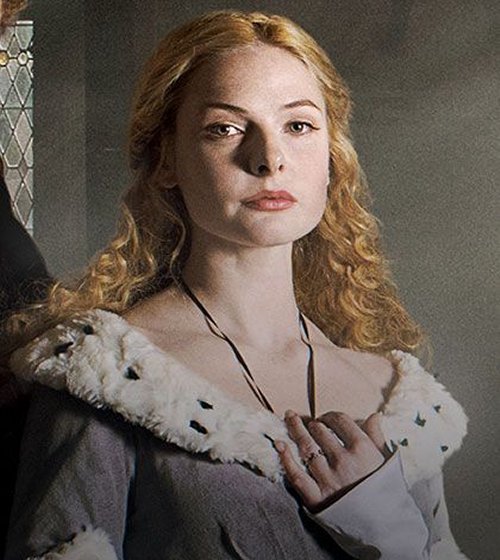 |
| |
|
Rick Archer's Note: Susan Higginbotham
(source)
is the author of five historical novels about
medieval England. I have taken excerpts from
her excellent article on Lord Hastings.
As with so much involving Richard III, there are
conflicting theories as to why William Hastings
met his death at the hands of Richard, Edward
IV’s supposedly devoted brother. Richard
himself claimed that Hastings had been plotting
against him, though he never produced any
proof to substantiate his claims.
Those defenders of Richard who have taken him at
his word suggest that Hastings was driven into
conspiracy by concerns that under the
protectorate, he would lose the power and
prestige he had enjoyed during Edward IV’s reign
or by his suspicion that Richard meant to take
the throne for himself.
The alternative explanation is that there was no
plot at all and that Richard, having planned to
seize the crown, ruthlessly eliminated Lord
Hastings as the man most likely to stand in his
way.
It is probably not a big surprise to readers of
this blog that I lean toward the second theory:
that of there being no plot by Hastings at all.
Richard had recently had three of the men
closest to Edward V—his uncle Anthony Woodville,
his half-brother Richard Grey, and his
chamberlain, Thomas Vaughan—arrested on equally
vague charges of conspiracy, which would never
be proven. They too would be executed
without trial.
Soon came the lies about the legitimacy of the
Woodville children. Richard and his
followers preached the story that Edward IV had
been pre-contracted to a woman named Eleanor
Butler before his marriage to Elizabeth
Woodville. This, in their opinion, made the latter marriage invalid
and the resulting children bastards.
Therefore Richard was the rightful king, not
Edward V (sitting in the Tower of London) or his
brother Richard (also sitting in the Tower).
The English Council agreed and Richard was
crowned King.
These
trumped-up allegations would never see the inside of an
ecclesiastical court, where they belonged.
In each case—Hastings, Woodville, Grey, Vaughan,
and the precontract—Richard would accuse, but
never prove. None of those involved were allowed
to defend themselves against Richard’s
allegations.
Woodville, Grey, and Vaughan were languishing in
prison at Pontrefact Castle when Hastings was
beheaded on 13 June. Their execution would
come 12 days later. Therefore, Hastings
was the first head to roll.
If Hastings could be assassinated in cold blood,
then anyone could be assassinated. Given
the immediate danger to the life of anyone who
spoke up, no one dared to press the point.
During Richard's coup d'état, the list was long and quite intimidating:
•
The
sudden, shocking execution of Hastings
•
The
trumped-up allegations concerning the illegitimacy of
Edward's children
•
The
arrests of others on June 13 and on June 14
(including the Archbishop of York, the Bishop of
Ely, Oliver King, secretary to Edward V, and
John Forster, an official of the queen)
•
The
previous arrests of Edward V’s associates
Woodville, Grey, and Vaughan and
their executions on June 25
•
The
large number of armed men sent to Westminster
Abbey to 'persuade' Elizabeth Woodville
to give up the Duke of York to Richard on June
16
•
The
rumors of massive numbers of troops headed from
the north, Richard's power base, to London
These were powerful incentives for those who
valued their heads to be docile, for the time
being at least. What must have made
Hastings’ execution all the more terrifying was
that he was no unpopular royal favorite, but
rather a
well liked, competent, and respected man who had
been associated with the Yorkist cause for
decades.
If Hastings could be assassinated in cold blood,
then anyone could be assassinated. Given
the immediate danger to the life of anyone who
spoke up, no one was safe. Consequently
there was little protest. Richard had
everyone cowered.
Susan Higginbotham
(original
source)
Two associated comments:
Laura says:
June 13, 2011 at 5:28 am
I find it heart-rending that Hastings' death
came at the hands of a man that he had eaten
and drank with, fought and bled beside.
Richard wanted Hastings out of the way
because he knew Hastings was the one person who
had the power and the strength of character
to stand up to his ambition. There is no
excuse for cold-blooded murder, yet that is
what Richard committed that day by refusing
Hastings the opportunity to exonerate
himself of those charges. Despite the fact
that Richard had other redeeming features,
that unjustified act stands out in my mind
as a defining moment for him. He preferred
the death of a loyal and trusted friend and
ally to his own greed and ambition.
Susan Higginbotham says:
June 13, 2011 at 7:43 am
Thanks, Laura! I quite agree. Even if
Hastings were actually plotting against
Richard, he could have been sent to the
Tower and given a trial. His hasty execution
suggests to me that Richard not only
regarded him as a threat to his ambitions,
but that he also knew that Hastings could
and would give evidence against the
existence of a precontract if left alive to
do so.
|
The Princes in the
Tower
|
|
|
|
Upon
hearing the news of her brother
Anthony's arrest, the Dowager Queen
knew Richard had betrayed her. Sensing she was
in great danger, Elizabeth fled to sanctuary
in Westminster Abbey together with her son by her
first marriage, her five
daughters, and her
other son Richard, Duke of
York.
On 16 June
s large number of armed
men were sent to 'persuade'
Elizabeth Woodville to give
up the Duke of York to Richard.
Elizabeth
Woodville was told to hand over the younger prince
Richard to the Archbishop of Canterbury so
that the
boy might attend his brother Edward's
coronation. She should have
never trusted these men. Richard was immediately
placed with his older brother Edward in the Tower of
London. After
that, things
went from very bad to much worse.
|
|
|
|
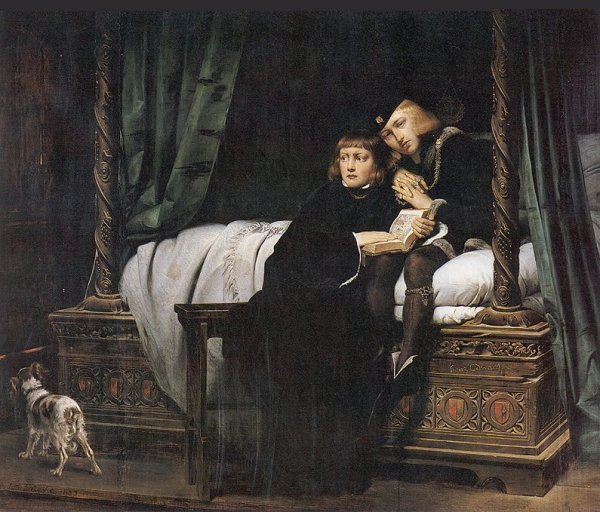 |
One day
before the scheduled coronation of young Edward,
Bishop Stillington of Bath and Wells announced that
the children of King Edward and his Queen, Elizabeth
Woodville, were illegitimate. Stillington
charged that before Edward IV married Elizabeth,
Edward had entered into a precontract for marriage
with another woman, Eleanor Butler.
This
action rendered the King’s marriage to Elizabeth
Woodville invalid. Thus, Prince Edward would
have been a bastard and ineligible to ascend to the
throne (and his brother as well).
On 22
June 1483, a sermon was preached outside Old St.
Paul's Cathedral declaring Edward's children
bastards and Richard the rightful king. Shortly
after, the citizens of London, both nobles and
commons, convened and drew up a petition asking
Richard to assume the throne.
This is
what Richard had hoped for. He was now legally
able to assume the crown. On 25 June, an
assembly of Lords and Commons declared Richard to be
the legitimate king.
Meanwhile, the two princes remained in the royal
apartments in the Tower of London. Sometime in late
summer or early fall of 1483, the boys disappeared
from view; there is no record of their having been
seen again. At the time the Princes vanished,
Richard and his new Queen were on “progress” in the
north of England, hundreds of miles from London.
|
A Footnote to History
Richard
was crowned as the new King of England on July 6.
The reign of King Richard the Third had begun.
Long live the King!! Or maybe not.
Two years later he would be dead.
Had
Richard not betrayed his nephews, there is every
possibility the York dynasty would have survived.
However, Richard’s own future would have been quite
difficult. Richard was despised by Elizabeth
Woodville and all of her relatives at court.
He would surely become the focus of Woodville
discontent. Edward V, the boy king, would have
followed his mother’s wishes when he came of age.
The boy had, after all, been raised and tutored by
his Woodville relations and hardly knew Richard.
No doubt Richard would have become a footnote to
history just like his brother George, the Duke of
Clarence. Richard was too ambitious to let
that happen. The boys had to go.
|
|
|
|
Indeed,
the two boys were never seen in public again.
The fate of Edward and his brother Richard remains
unknown to this day. The most widely accepted
theory is they were murdered on the orders of their
uncle, King Richard. Thomas More wrote the
princes were smothered to death with their pillows.
His account forms the basis of William Shakespeare's
Richard III, in which Richard orders
Tyrrell to murder the princes.
Since
there is no proof of what really happened, many
different theories have surfaced over the years.
However, these competing theories are nowhere near as
plausible as the straightforward one pointing to
Richard. Richard controlled access to the
boys, Richard was responsible for their welfare, and
Richard is the one who stood to gain the most by
their murder. Furthermore, if someone else was
responsible for their deaths, why didn't Richard cry
foul at the top of his lungs and conduct a public
investigation?
Guilty? Most people think
so, especially after seeing Shakespeare's Richard III.
Bones belonging to two children were discovered in
1674 by workmen rebuilding a stairway in the Tower.
On the orders of King Charles II, these were
subsequently placed in Westminster Abbey, in an urn
bearing the names of Edward and Richard. The
bones were reexamined in 1933 at which time it was
discovered the skeletons were incomplete and had
been interred with animal bones. It has never been
proven that the bones belonged to the princes, and
it is possible that they were buried before the
reconstruction of that part of the Tower of London.
Permission for a subsequent examination has been
refused.
In 1789, workmen carrying out repairs in St George's
Chapel, Windsor, rediscovered and accidentally broke
into the vault of Edward IV and Elizabeth Woodville.
Adjoining this was another vault, which was found to
contain the coffins of two children. This tomb was
inscribed with the names of two of Edward IV's
children: George, 1st Duke of Bedford, who had died
at the age of 2; and Mary of York who had died at
the age of 14. Both had died before the King.
However, the remains of these two children were
later found elsewhere in the chapel, leaving the
occupants of the children's coffins within the tomb
unknown.
|
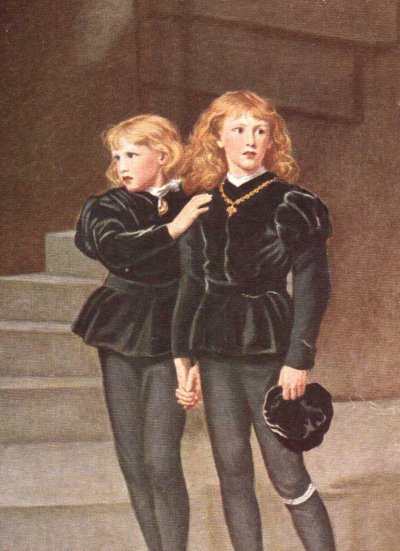 |
| |
Biographies
Transitions were
always perilous times in Medieval England.
Power-hungry people viewed transitions as
opportunities to exploit the leadership vacuum to
advance their own ambitions.
Keep in
mind that the War of the Roses spanned over thirty
years. Following the 1471 Battle of
Tewkesbury, King Edward IV ruled unopposed for
twelve years.
During
that time, an entire new generation of faces moved
into position. So let us detour from the
treachery of Richard and learn more about the
background stories that make Act III: Richard
III so compelling.
|
 |
The Madness of King
Charles
Charles
VI was better known as Mad King Charles.
The best
known story about Charles took place in 1392.
Charles was 24. In April, Charles suffered
from a mysterious illness which caused his hair and
nails to fall out. That summer, Charles was
hardly recovered. He still suffered from
occasional bouts of fever and behaved incoherently
at times. One day Charles and his men set out
on an expedition. One of his advisors had
barely survived an assassination attempt. Now
Charles went looking for the fugitive assassin.
On a hot
day in August, Charles was riding through the forest
at the head of a group of knights when a
wild-looking man ran up to his horse and spoke some
words of doom and betrayal.
The
soldiers chased the man away, but Charles' nerves
were clearly disturbed. Charles absolutely
freaked out.
|
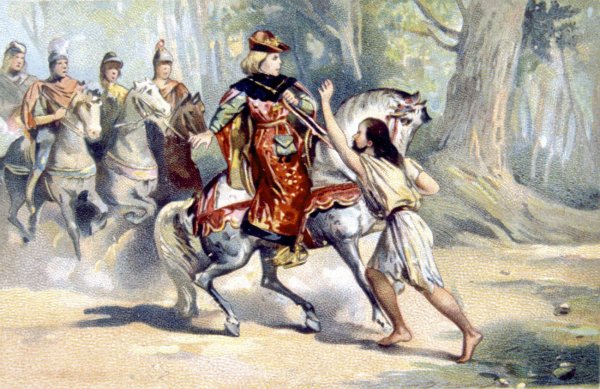 |
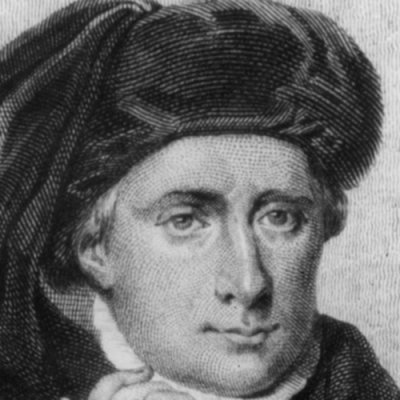 |
Leaving
the man behind,
the group continued their
journey. Soon after, a page accidentally
dropped a lance. Charles flipped out.
Without warning, he rushed forward with a drawn
sword and killed four of his men. The astonished
victims did not even defend themselves, assuming the
king had the right to kill them if he wanted to.
Finally
the others overcame their shock and overpowered the
king. Lifted from his horse, Charles lay flat
and speechless on the ground, his eyes rolling
wildly from side to side. His attendants found
an ox-cart to carry him. For two days Charles
was in a coma. When Charles heard that he had
killed four of his own men, he wept.
From
then on his mental health was seriously undermined.
Charles would go through
episodes of forgetting people's names, including his
own, and the fact that he was king. Occasionally he
would run through his castle howling at people; he
was pretending to be a wolf. When his spells
were upon him, he would sit in a room, motionless,
for hours. If he did move, he did so with extreme
caution. Questioned about this, he claimed
that he was made of glass, and one wrong move would
shatter him.
Charles
suffered from severe schizophrenia.
Mental illness ran
rampant in the family. Desperately ill, he was
delusional. At times he believed his enemies were
upon him and would be thrashing and fighting off the
invisible foes. But King Charles was not the only
one in the family who was mad. His
mother, Joan of Bourbon was unbalanced.
She became totally deranged after giving
birth to her seventh child. Her father, uncles, and
grandfather also suffered mental maladies.
|
| |
The
problem with having a Mad King is the fact that the
Kingdom of France depended on him.
Charles became king of France in 1380 when he was
12. He ruled for 42 years till his death in
1422. All 42 years took place during the worst
part of the Hundred Years' War with England. Yes, the same
hundred years when England plundered and humiliated
France time and time again. Was Charles was part of
the problem? Well, what do you think?
When
your country is fighting something called the 'Hundred
Years' War', it's really unfortunate if the man
sitting on the throne is nicknamed 'Mad King
Charles'... unless of course it means he's
really angry at someone. No, he was just nuts.
The
question the reader might be asking is why I am
discussing a French King who died 60 years before
Richard the Third became king of England.
There are two things the English people are very
squeamish about in regards to their kings... illegitimacy
and madness.
There
have definitely been English kings who were crazy.
Mad King George III comes to mind. His madness
led directly to a certain well-known war known as
the American Revolution. This madness stuff in
a king can be incredibly costly to a nation.
So now I
have question. This has
been a very long and quite complicated story, but can you remember
WHO was
most responsible for creating the War of the Roses?
Let's see if you
get it
right. Scroll down.
|
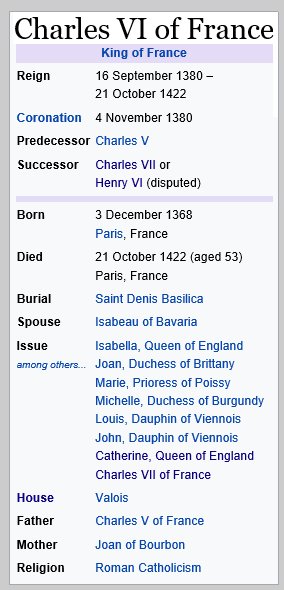 |
|
|
Keep
scrolling.
|
|
|
A Very
Naughty Girl
|
|
|
|
|
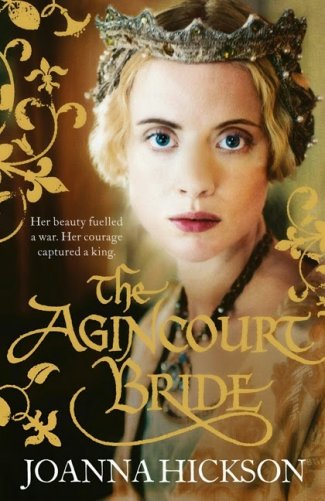 |
Did you answer Richard, Duke of
York? Close, but he's not the best answer.
Did you
answer Margaret of Anjou? Closer, but she's
not the answer either.
Did you
answer French King Charles the Sixth?
You're getting warmer.
The
madness of Charles VI let England have its way with
France for half a century. Thanks in large
part to the cruelty of England's Black Prince, countless
men were murdered, women were raped, fields
were burned, and townships were pillaged and leveled.
Did you
answer Catherine of Valois? Considering her
picture is hard to miss, that would be a good guess,
but we are still not quite there yet.
The best
answer is Henry the Sixth.
Mad King Henry the Sixth was the direct
descendant of Mad
King Charles the Sixth. The
humiliating defeat of
Agincourt took place during the reign of Charles
VI. With Charles incapacitated at the time of
Agincourt, his wife Isabelle allowed King Henry V,
the enemy, to marry beautiful daughter Catherine
Valois (who just happened to be a little nutty
herself).
This
marriage inadvertently linked Catherine to one of
the greatest ironies in history. Catherine
would inadvertently carry out the revenge of French
King Charles VI on England. As we know,
Catherine passed on the seed of madness to her son, the sad, bewildered
King Henry VI. It seems almost karmic that by marrying his daughter Catherine
to Henry V, hero of Agincourt, Charles made
sure his family's hereditary madness crossed the English Channel.
|
Here is
a sad reality... England was absurdly dominant over
France during the reign of Charles VI.
With the
Hundred Years War lasting from 1337 to 1453, out of
those 116 years, France did not gain the upper hand
until the final days of the conflict. What can
explain the change in momentum? Henry VI.
The
historians will say Charles VI died in 1422 and
Charles VII, better known as 'Charles the
Victorious', took over. The historians
will also point out that Henry V, a fierce warrior,
died the exact same year.
And who
took his place? Henry VI.
England's king had gone from a stud to a simpleton.
The
course of the war changed instantly. But Henry
VI wasn't done yet. When the Hundred Years War
ended in 1453, a new war took its place. 1453
was the start date of a new conflict. Henry's
madness created the War of the Roses. Surely
in the French equivalent of Valhalla, Charles VI was
laughing.
|
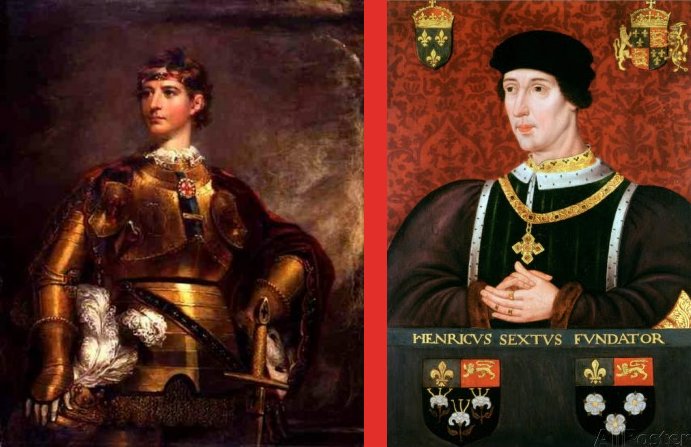 |
Illegitimacy and
the Throne
|
| |
|
A major
scourge of the 21st Century are computer viruses.
Charles VI had planted a time bomb virus of another
sort in the English bloodline. The mental illness of
Catherine's son King Henry VI was more responsible
for the War of the Roses than any other factor
because it encouraged the subsequent free for all
power grab. When a King goes mad, the country
goes to hell. And when the country goes to
hell, it is usually because there is a power vacuum
at the top. The madness of Charles had led to the devastation of
France during the Hundred Years War. Now that
same madness gave
England its equally destructive War of the Roses by
encouraging the power hungry nobles and relatives to
seize power for themselves.
Let us
review the damage caused by Henry VI.
•
His
incompetence led to England's humiliating collapse
at the end of the Hundred Years War.
•
His
weakness led to the enormous social and political
problems in England which led to the War of the
Roses.
•
His
inability to reproduce led his wife to have the
affair with Edmund Beaufort which led to Edward of
Westminster.
If not
for Edward's miracle victory at the Battle of
Barnet, England would have had its next illegitimate
king.
'Next'
illegitimate king? Uh oh.
Let's be
clear on something... there is current DNA evidence
that proves beyond a shadow of a doubt that
illegitimacy occurred somewhere in the English line
of kings, perhaps even several times. For
example, we might recall the story where King Edward
the Fourth's own mother, Duchess Cecily Neville,
claimed her son Edward was the illegitimate spawn of
her fling with an obscure archer. It is said
that Edward was very good with a bow and better
looking than his mother's husband. Surely that
is all the proof we need.
England
may have dodged the illegitimacy problem with Henry
VI, but his mother Catherine went out and made
things much worse. Yes, indeed, as it turned
out, Catherine of Valois was not through wreaking
her reproductive damage upon England.
Catherine was
the gift that kept on giving. England
mistreated her, so she mistreated England right
back. Not only did she give
England her father's madness, there is a strong possibility that
Catherine gave England
its next illegitimate king.
Personally, I have never understood why people make
such a big case out of illegitimate birth. I
hate the way people look down on a bastard child.
Why punish the child for the sins of the parents?
To me, the child should be judged on the quality of
his or her actions, not the parentage. For
example, England's William the Conqueror was born a
bastard and look what he accomplished.
However,
I also understand that various religions contend
that children born out of wedlock must carry a
stigma. This consideration may not be
important to me, but it is to some people. I
guess illegitimacy is one of those issues where one
has to make up their own mind.
One of
the interesting things about illegitimate kings is
the possibility that the bastard child may be a
much-needed 'upgrade'. For
example, Russia's Catherine the Great was married to
an idiot named Peter the Third. Her son Paul
was the likely product of Catherine's affair with
Sergei Saltykov, a talented Russian officer.
Paul very easily could have been one of Russia's
great rulers. Unfortunately he was
assassinated five years into his reign. And
why was that? Paul did something unforgivable.
Paul had the nerve to help the miserable serfs. In
fact, he was Russia's version of Robin Hood - steal
from the rich and give to the poor. That got
him killed.
Ah, but
I digress. Back to England. Margaret of
Anjou had spent seven years waiting for Henry VI to
impregnate her. Without an heir, Richard of
York threatened to claim the throne. So what
is a girl to do?
This
offers the perfect opportunity to tell a dirty joke.
So Mrs. Smith, pregnant with her first child
after such a long wait, visits her neighbor's
barn to buy some eggs.
Mrs. Smith, "Oh, Farmer John, look at all the
hens you have! Last time I was here, you
had only half as many. Where did you get
so many hens?"
Farmer John, "It wasn't that hard. The
previous rooster wasn't getting the job done, so
I switched cocks."
Mrs. Smith, "Interesting how that works."
More than likely, Margaret of Anjou's enduring love
affair with her favorite advisor produced Edward of
Westminster, the boy who died at Tewkesbury.
So was this child an upgrade? Tough question.
As the product of two ruthless, ambitious parents,
it is debatable how their reportedly cruel son would
have turned out as king. As it was, England
narrowly missed placing another illegitimate ruler
on throne. Oh, by the way, Joffrey on
Game of Thrones, Edward's Doppelgänger, was
also illegitimate.
When
looking for the break in the royal lineage, one
place the scholars always point to is Catherine of
Valois. Catherine's son Edmund Tudor was born
in 1431, nine years after the death of her husband
Henry V. Catherine was a widow at the time.
There
are two kinds of illegitimate children. There
are children born out of wedlock and there are
children born of adulterous affairs. To me,
the allegation that Edward IV was the product of his
mother's liaison with a lowly archer as opposed to
his brilliant father is far more serious than
Catherine giving birth to a child while she was
single and forbidden to marry.
'Forbidden
to marry'?? Surely there is a story here
and indeed there is.
| |
|
As
historic figures go, I would imagine very few people
today have the slightest clue who Catherine of
Valois is. Although she was immortalized by
Shakespeare as Henry V's 'Fair Catherine',
she has nevertheless remained an enigma with little
written about her. Long ago Catherine was
dismissed by historians as nothing
more than a perpetual footnote in the history of
this period. Through the centuries the story
of Catherine of Valois has largely been forgotten.
I find this surprising because my research shows
that Catherine unwittingly had a dramatic and
lasting impact on English history.
Perhaps
the key word here is 'unwitting'. By
reading between the lines of the narratives, I
gather that Catherine was pushed around her entire
life. Given the fact that she gave birth to a
simpleton (Henry VI) and showed no ambition for
politics suggests that Catherine herself
may not have been the sharpest knife in the drawer.
That said, her story dominated the 15th century
tabloids. Catherine's life was touched by
a cruel
childhood, mental illness, political mistreatment,
a clandestine
marriage, and secret
illegitimate children.
Catherine was
the youngest of eight
children born to King Charles VI of France and
Isabelle of Bavaria. We
already know that Catherine's father was a basket
case, but now we discover her mother was just as
bad in a different way. Her mother, Isabelle, was
haughty, callous, and shamelessly adulterous to
Catherine's
poor ailing father. Isabelle took advantage of
the king’s frailties and seized control of the
kingdom from usurpers. Isabelle was so busy
with politics, poor Catherine and her siblings were
neglected. As opposed to the pampered life of
a princess one would expect, Catherine and her
siblings would live like paupers in miserable
surroundings.
|
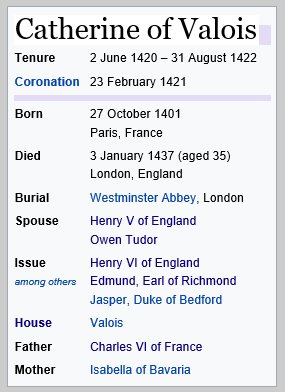 |
| |
|
As
King Charles continued his
descent to madness, Isabelle decided to hide
the King from the public.
When Catherine was 3, her mother moved Charles from
the palace and placed him
in a royal Paris residence
known as Hotel de Saint Pol
along with his children. Catherine
was nowhere near the corridors of power as a
child... and that's the way her mother wanted it.
Out of sight, out of mind.
Isabelle's
mission completed, the wildly unpopular Queen
devoted her time to the pursuit of
pleasure, pilfering the treasury, and showering her
favorites with riches. In contrast, contemporary
chroniclers noted the 'piteous state' of the young
Princess Catherine and her siblings, 'nearly starved
and loathsome with dirt, having no change of
clothes, nor even of linen'. The Queen was so
negligent that she made no provision for her husband
and children. Content that they remain locked away
far from sight, she neglected to ensure that the
servants at Saint Pol were being paid for their
labor. Consequently, as time went on,
many were forced to find work elsewhere, leaving
the royal children and their ailing father wholly
dependent on the few faithful servants who remained.
There is
much more intrigue I could add about Catherine's
childhood, but let's just say that
Isabelle
invested little energy in her child's welfare.
Isabelle
was an ambitious woman with a cruel and ruthless
determination to advance her own affairs.
It was Isabelle who decided
to use her young daughter Catherine as a bargaining
chip with Henry V, the powerful king of England.
As we
know, the marriage ended in the tragic death of
Henry V to dysentery.
Catherine had the briefest of reigns as the queen
consort of England from 1420 until 1422. She
gave birth to crown heir Henry VI in December 1421.
With her husband over in France conducting yet
another war, it is said that Henry V died without
once seeing his son. Catherine's grief was
reported to be most violent.
Time
passed. Seemingly content to remain somewhat
aloof, Catherine made no strong alliances one way or
the other while in mourning. Some say the
Queen Dowager was in an incredibly powerful
position. Catherine was young, attractive and
wealthy as well as the mother of the King of France
and England. Unfortunately, she didn't act
very powerful. Thanks in large part to her
sad, pathetic childhood, Catherine had little
ambition of her own and virtually no instincts for
playing politics. In a sense, she was a
shy weakling just as her royal son would turn
out to be. Her English was poor and she had
few friends in high places on the English council.
But she was still Fair Catherine... men came to
visit.
The
Council did not know what to do with Catherine.
Another marriage involving Catherine could spell
disaster for internal English politics as well as
complicate their current standing with France.
Worried that Catherine would raise her child to have
French sympathies, in 1425 Catherine's regent
Humphrey decided that young King Henry VI, 4, should
be removed from his mother’s care and placed into a
separate household. Catherine's new role
became more like that of a favored aunt. She
could see the child from time to time, but was
removed on a daily basis. Reports say that
Catherine appeared to accept this and be content
with her role. If so, her passivity gives us a
major clue. What normal mother would accept
this arrangement? We certainly could never
imagine Margaret of Anjou letting a similar thing
happen to her beloved Joffrey, er, Edward.
With her
husband dead, once her
child was taken away, it seems like Catherine's remaining
purpose in life had been badly damaged.
Catherine of
Valois was
now a
25-year old widow with no children, living in the
wrong country, and nothing to do. Rich and
beautiful, it is no surprise that Catherine
fell in with the younger set at court.
At this time, Catherine was said to have
difficulty “curbing her carnal passions”.
Don't we all? Some handle
it better than others, but Catherine apparently let
her Scorpio nature get the better of her.
It was
only a matter of time before a girl looking for a
good time ran into a very bad boy.
|
If nothing
else, the War of the Roses is the story of ambition
gone mad.
In
particular, Catherine became infatuated with
the highly ambitious Edmund Beaufort,
an emerging political figure.
Edmund Beaufort...
where have we heard that name before? This is
the same Edmund Beaufort who was the major political
rival of Richard, Duke of York, back in Act One of
our narrative.
Edmund Beaufort was not just the
main advisor to Margaret of Anjou, he was also her
boyfriend. Edmund
Beaufort was likely responsible for
impregnating Margaret with her son Edward.
Sad to
say, Edmund Beaufort's ambition would cost him
dearly. His decision to back Margaret of Anjou
throughout the War of Roses would doom two
generations of his Lancaster-based family to death.
Thanks
in large part to Edmund Beaufort, the entire male
side of his Beaufort family was obliterated.
Can you even imagine? Six men died fighting!!
However,
perhaps Edmund Beaufort got the last laugh.
Back in his younger days, it is very likely Edmund
was the true father of Edmund Tudor, the man who
would in turn sire Henry VII, the future king
of England.
So was
it love or lust between Fair Catherine and Edmund
Beaufort? Or was it her untold wealth?
For that matter, the next boy to emerge from her
womb would have a claim to be the future King of
France.
In very
simple terms, Catherine was a good catch.
Maybe too good a catch... her Regents were very
alarmed at this romance, especially when Edmund, 22,
asked permission to marry Catherine, 27.
Enter
Humphrey, Duke of Gloucester, to the stage.
Humphrey was not only the current Regent of England,
but as the uncle of the child Henry VI, he was also the
child's Lord Protector.
When
Humphrey heard the rumor in 1428 that Edmund
Beaufort sought to marry
Henry's mother, Humphrey put his
foot down and said no.
With
Cardinal Henry Beaufort as his main political rival,
the last thing Humphrey wanted to do was to muddy
the waters by giving more power to yet another
Über-ambitious Beaufort.
|
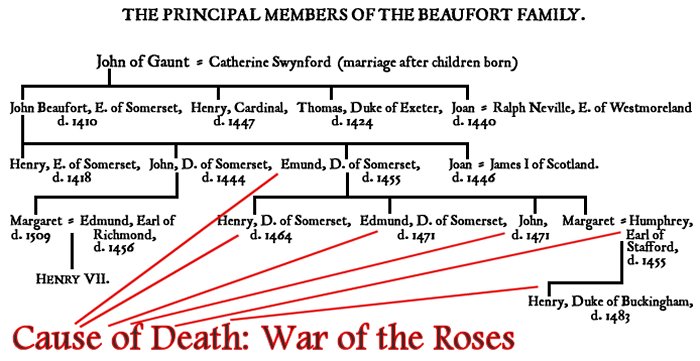
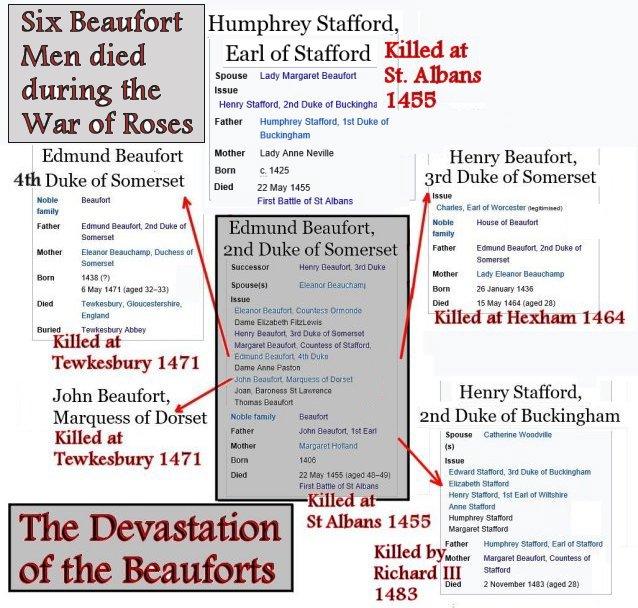 |
Humphrey feared that if this highly
desirable young widow decided to marry, her Beaufort husband
might gain undue influence over his young stepson
(Henry VI) and upset the balance of power.
Catherine's French nationality was never far from the
minds of the Council. If she should decide to
ally herself with a member of the French nobility,
the situation would be even more fraught with
difficulties.
Such was
the fear of remarriage that Parliament was persuaded
to pass a 1428 law prohibiting any person from
marrying the dowager queen without the consent of
the King and Council. They played a dirty
trick on Catherine... there was no king at the time
to give permission!! The country was being
ruled by Humphrey who was 'not a king'. If Catherine wanted to marry
Edmund, she would have to wait nine years until her
son Henry, 6, came of age in 1437. So
much for Catherine's hopes to remarry.
No doubt
Edmund gave up all hope of marrying Catherine.
A deeply ambitious man, Edmund wasn't about to
jeopardize his career by risking marriage to a
Forbidden Woman. On the other hand, there was
no law that prevented Edmund from continuing to see
Catherine under the radar and under the blankets.
England is a very chilly place and what better place
to seek warmth than the arms of a beautiful
woman?
No doubt
the Council thought itself clever to disempower the
Dowager Queen, but there is a real chance their
decision backfired in a very remarkable way. One can easily imagine the
intense bitterness Catherine felt at having her love
life so blatantly interfered with. No one
likes being unfairly pushed around. Therefore it comes as
no surprise that Catherine may have rebelled in a
very unusual way.
In 2013
historian John Ashdown-Hill published a book called
Royal Marriage Secrets. In his
book Ashdown-Hill said he had uncovered evidence
that Edmund Tudor, father of Henry VII, was not the
son of Owen Tudor but rather that of Edmund
Beaufort.
Needless
to say, this ignited considerable controversy.
Many erudite people wrote long rebuttals to
deny Ashdown-Hill's claims. Other people said this
proved what they had believed for a long time.
Still others read the book and decided they had a
better claim to be King or Queen of England than the
current royal family. Lord knows, we might
just have another War of the Roses right here in the
21st Century.
|
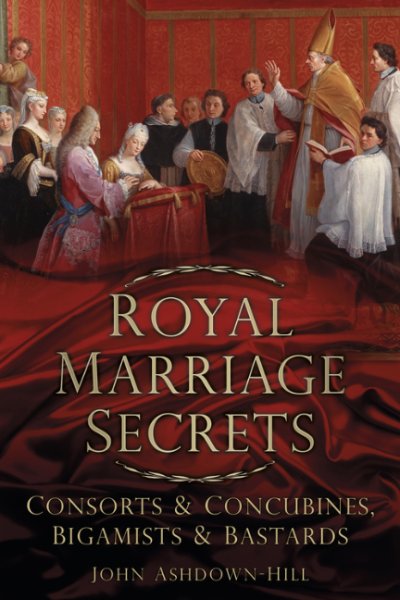 |
| |
|
In the
meantime, I have one word of wisdom. Since the
English take these matters very seriously, if you
ever visit England, don't make any jokes about the
legitimacy of various kings. After all, due to
King Edward III siring dozens upon dozens of children, 99% of all
English citizens have at least a few drops of royal blood in them.
For that
matter, maybe I am related to that Archer who got
Cicely Neville pregnant with future king Edward the
Fourth. I think I will start a rebellion when
I visit England. What a shame it is that
Shakespeare isn't still around to write 'Richard the
Fourth'.
|
| |
|
Owen Tudor is the man who
allegedly fathered Edmund
Tudor by Catherine of Valois, the former Queen of
England.
Edmund
Tudor would later father Henry Tudor who went to
become Henry VII, the
first Tudor king of England.
Henry VII could point to his paternal
grandmother Catherine of Valois as the source of his
Royal Blood.
However,
there was problem after problem with Henry's family
tree.
One
problem was that Edmund Tudor was mostly likely a
bastard.
Another
problem was that Owen Tudor probably wasn't Edmund
Tudor's father to begin with.
Embarrassing as this sounds, Edmund Tudor's mother
was a Beaufort and Edmund Tudor's father was a
Beaufort. If this is true, then it
means the royal house of 'Tudor'
sprang from Beauforts on both sides. In other
words, his parents were first cousins!!
Except
that History doesn't see it that way. History
tells us Owen Tudor, a very unremarkable man, was a
servant who allegedly seduced the former Queen of
England. So how did he do it? How did a
lowly servant persuade a woman with the highest
prestige into his bed?
In other
words, if the truth had been known, there would have
been great scandal. So a whopper of a
tale was created to keep the true parentage of Henry
VII a complete secret.
|
| |
|
 |
| |
|
It is
said that Queen Catherine of Valois found Owen to be
so irresistible that she gave her heart, soul... and
yes, body... to this handsome young man.
No big
deal until we realize that Owen was not an estate
owner with a pedigree and vast lands under his
control. No, not hardly. Owen Tudor was
not exactly high-born. In fact, he was the
lowly son of a Welsh rebel who became a servant in
Catherine's wardrobe department
This is
one of the most curious stories of parentage
imaginable. By favoring this particular
servant with her charms, some of England's most
famous kings.... Henry the Seventh, Henry the Eighth
and Elizabeth the First could point to a lowly
chamber boy as their forefather. Impressive,
yes?
Or maybe
not. Considering my own roots include a Welsh
undertaker gracing the family tree, finally I have a
story I can relate to! Oh, the shame of it
all.
Since
Owen Tudor is the newest member of our narrative,
let us introduce him properly. Born in 1400,
Owen was a nobody who worked in the household of the
Dowager Queen and somehow ended up in the Queen's
bed. It is said that their lovemaking produced
a boy named Edmund Tudor, the eventual
father of Henry VII, the king who
would begin the Tudor dynasty of England.
This is
a very curious story. We hear rumors of
powerful men who inveigle or coerce susceptible
chambermaids into their bed and then discard them
quickly. What we don't hear very often are
stories of a beautiful Queen, a woman coveted by
extraordinary men in high places, who chooses
instead to seduce the keeper of her wardrobe and
linen. But no, the story doesn't stop there.
The chamber boy impregnates the Queen. Oh, darn, well,
these things happen. Just ask Cecily Neville,
victim of that handsome Archer boy.
Big
deal. So, all Catherine has to do is find some
noble and ask him to be noble and cover it up.
Or have the child on the sly and hand it to some
peasant to raise. But no, the Queen keeps the
child!! And why? Because she has fallen
in love with Chamber Boy! She leaves the
palace with chamber boy and they live happily ever
after out in the countryside, having four more children along the way. What a
remarkable story!
In 1421
Owen is said to have gone to war in France.
However, he was not a warrior. Instead Owen
assisted Sir Walter Hungerford, a steward in the
service of Henry V (Agincourt). Following
Henry's death, Owen somehow ended up as a keeper of
the Queen's household or wardrobe back in England.
Virtually nothing is known about how the liaison
between Catherine and Owen took place.
Consequently there are all sorts of 'Legends'
about their meeting, which is another way of saying
that someone decided to make up stories.
For
example, one writer said that Owen came to the
queen's attention when she spied him bathing naked.
Another chronicler dwelt upon Owen's good looks
which the Queen Mother noticed, causing her to give
the handsome squire a post in her household.
And then there was the legend that Owen either
deliberately or accidentally fell onto the queen's
lap during a drunken dance.
My
favorite was the lap story. While on guard at
Windsor Castle during some festivities, Owen was
required to dance before the court. Queen
Catherine sat on a low seat surrounded by her
ladies. While making an elaborate pirouette, the
unfortunate man lost his balance and fell headfirst
into the Queen's lap. The Queen's manner of
excusing this was so awkward that her ladies in
waiting grew suspicious that the Queen had a thing
for this handsome Welshman.
Whatever
the true story, there can be no doubt that Catherine
and Owen were taking a huge risk. Catherine
lived in the king's household, presumably so she
could care for her young son when called upon, but
mostly so the councilors could watch over the Queen
herself. Knowing full well there were spies
everywhere, Owen and Catherine's mad love affair was
sheer madness.
Seriously, this story is so far-fetched it
absolutely stretches the imagination. We are
supposed to believe the man who won Catherine body
and soul, the man for whom she risked everything,
was her handsome Clerk of the Wardrobe! A trumpet
for the strumpet, please! If this were
fiction, I'd toss the book in the trash as rubbish.
But that is apparently more or less what happened.
(Or
at least that is what they would have us believe!!)
Despite
all the risks, the Queen and the servant began their
affair right under the noses of people who were paid
to watch her. The queen was under suspicion.
She was a foreigner with few friends. Many
suspected Catherine of secretly supporting her
brother Louis VII's claim to the French crown over
her that of own son little Henry VI.
Personally, I think there has to be a more likely
explanation for this unlikely pairing. One
explanation would be rebellion. The assholes,
oops, I meant the dignitaries who ruled England in
the name of Catherine's son expected the queen to be
content to sleep with her fond memories of the great
Henry the Fifth. One can assume Catherine felt
considerable resentment.
One
might even conclude her affair with Owen was her way
of thumbing her nose at these men. Perhaps
this good-looking servant was the only option
available to a desperately lonely woman trapped in a
cold, unfriendly castle.
Thus
began the mad love affair between the widow of the
revered King Henry and her studly Clerk of the
Wardrobe. I say 'mad' because the two
risked a charge of treason. Based on that
crazy statute, one or both of them could easily end
up in jail... or worse. We've heard of men who
lose their head over a woman, but in this case, it
could really happen!
Then one
day Catherine realized she was pregnant. Uh
oh.
All the
history books point to Owen Tudor as the father.
Maybe the thing to do here is to read between the
Lies. First Owen risks his neck to impregnate
the Forbidden Queen and then Catherine turns around
and names her son 'Edmund'.
Huh?
'Edmund'. Such a curious choice of
names. Edmund was the name of Catherine's
former boyfriend. Are we missing something here???
|
 |
|
 |
 |
The 11
December 2016 episode of the TV show The
Royals revolved around the legendary story
of Owen and Catherine. As one can see, their
tale was an "epic, earth-shattering love
affair!"
Forgive
me, Father, for I am about to be catty.
As I
read further, I realized the writer of the 'earth-shattering
love affair' blog had basically accepted the
Owen-Catherine Fairy Tale hook, line, and
sinker. I doubt very seriously the writer dug
very deeply into the story. This is not
necessarily a good thing. After all, it is my
understanding that the motto of most TV shows is 'Why
let the truth get in the way of a good story?'
It is
scary to realize most of our history lessons these
days come from movies and television.
Currently our world is awash in a phenomenon known
as 'Fake News'. There has probably never been
a time when ignorance and superficial thinking has
been more prevalent. We base our decisions on
the words of people we don't know personally.
This may not be a very good idea. Rumor has it
our leaders deliberately tell fibs from time to
time.
I
suppose I am just as guilty as the rest of
superficial thought. I have based this entire
story about the War of the Roses on the ten
listings that appear on the First page of Google.
I pick a few a random and take a peek. If it
sounds intelligent, I borrow a few ideas. But
that doesn't mean they are correct. Most of
the time, I don't even know the name of the author.
Research
these days is little more than cut and paste.
It is shocking in a way how many websites simply
repeat what another website says VERBATIM. For
example, Wikipedia, the source for many of my
explanations, makes it effortless to cut and paste
passages into my stories. I love Wikipedia,
but I don't always trust it.
Every
now and then, I stop and think about it... I am
repeating the words of Wikipedia contributors who I
know nothing about. Here's another old
saying... you get what you pay for.
Wikipedia is free. The entire site was created
by volunteers. Who vets the Wikipedia writers?
I am
about to challenge the 'Owen-Catherine Fairy Tale'.
I believe this particular legend may not be what it
seems. In a sense, I will attempt to rewrite
history. If you find yourself agreeing with my
line of thinking, before you make up your mind,
please remember to ask yourself this question:
Do you really want to form your opinion based on
the words of a retired dance teacher who gets
his information from the Internet?
It all
boils down to Credibility. Question
everything, my friend.
|
 |
Scandal in the
Castle: Who's Your Daddy???
|
I
contend that the
weird circumstances surrounding Catherine's
pregnancy suggests an alternative explanation for
Catherine's risky behavior... Edmund Beaufort.
No one
is quite sure when Catherine's affair with Owen
Tudor began.
•
One
website suggested 'somewhere between 1427
and 1429'.
•
Another
website reported 'About 1428 or 1429'.
•
Another
website reported, 'Despite all of this, Catherine
did remarry in secret, sometime in 1431 or
1432'.
•
A
third website said, 'It is accepted that
Catherine and Owen were married sometime around
1429/30'.
I am not
making this up. In fact, I'm not making any of
this up. I just drift from website to website
compiling the information, then I try to sort it
out. Do you know what the words 'Somewhere', 'About',
'Sometime', and 'Around' mean to me?
These
words mean someone is guessing. It means no one
knows the truth about these dates because both the
affair between Catherine and Edmund and the affair
between Catherine and Owen were conducted in secret.
I would place a bet that there are no existing
written accounts of what took place in the castle.

The
passage above is another good example of the general
fuzziness surrounding Owen and Catherine's supposed
Love Story. I am starting to believe we have a
genuine mystery on our hands.
•
'many
tales, unsupported...'
In other words, no one knows
the true story of how Owen and Catherine hooked up.
•
'We
don't know for sure what position Owen held.'
This suggests that no
one ever wrote any history of this liaison.
•
'Despite
all the romantic embellishments by later writers.'
Someone makes stuff up
like the 'Lap Story' and the next person buys
it.
•
'It
seems that Owen and Catherine were attracted to one
another.'
Gee, can we possibly be less
certain about this?
I believe
the words above are the words of an ethical writer.
This person has taken a good look at the existing
data and realized this very well could be a fable of
some sort. Embarrassed at being forced to
regurgitate literary diatribe based on quicksand,
the writer has hedged his or her bet by qualifying
every single phrase for the simple reason that no
one has a clue what really happened.
So I
suggest we read between the lines... maybe there is
a cover-up going on here. Maybe this entire
love story is nothing more than putting lipstick on
a pig.
We
started this chapter by asking a question:
How did a lowly Welshman bed a Queen?
Six
centuries have passed since the Owen-Catherine Love
Story took place. Someone compared it to a 'Remarkable
Fairy Tale'. Every single writer focuses
on how incredible
it was that a highly desirable Queen could allow
herself to be seduced by
a lowly servant, a young man who actually risked
death to take this woman to bed.

Yes,
indeed, it all sounds very romantic, but at heart
the idea is preposterous when you stop and think
about. It is hard to believe the 'epic,
earth-shattering love affair' between Owen and
Catherine actually took place because it challenges
our reality-testing equipment to the extreme.
This story is absolutely begging for a better
explanation!!
I don't
deny something unusual took place between Owen and
Catherine. After all, while she was still
pregnant, Catherine left the comfort of the castle
with Owen and had four or five children by him over
the next few years while
living out in the country. The Queen
definitely built the final part of her life around
this man. That part is not in question.
| |
|
What I
am suggesting is that the Edmund Beaufort Rumor invites us to
reinterpret the initial stages
of the Love Story in a different
light. Since clearly no one really knows what
took place here, I have decided to offer my own
theory.
What would
Catherine do if Edmund Beaufort really was
the father?
The
truth is that a lowly Welshman does NOT bed a
Queen... but a Queen might bed a lowly Welshman
if she had a good reason.
Given
the general fuzziness regarding the time line, Catherine's
two affairs could very easily have overlapped in
some way.
Keep in mind that Edmund Beaufort was the
leader of the formidable House of Beaufort.
He had his entire career ahead of him.
He had possession of the vast lands known as
'Somerset' in southwest England.
Beaufort stood to lose everything.
Let us
return to that law forbidding Catherine to
marry. Some
highly vindictive men had made it a grave offense to
marry the Queen Dowager without their consent. That
law was passed in direct retaliation for Edmund
Beaufort's interest in Queen Catherine. Quite
likely, after the law was passed, extra scrutiny was
placed around the Queen just to be on the safe side.
Catherine began to look over her shoulder in case
spies lurked behind the curtains and under her bed.
Catherine had to do something to hide her
pregnancy before the spies figured it out.
If
Edmund was responsible for Catherine's pregnancy, is
it possible that Catherine would turn to Owen in order
to protect Edmund?
|
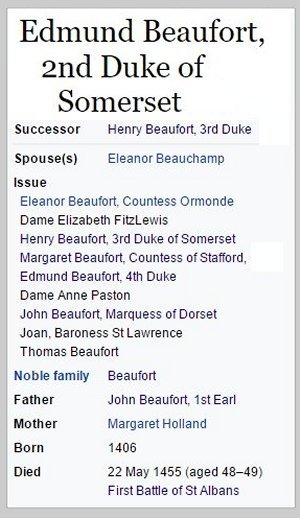 |
| |
|
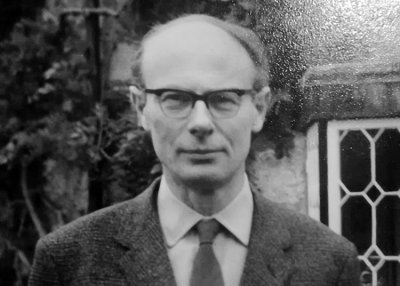 |
Gerald Harriss (1925-2014) was one of the
most distinguished English medievalists of
his generation. Harriss was an
eloquent interpreter of the workings of
English late-medieval political society,
illuminating not only its institutional
aspects but also the characters of its
leading actors, notably Cardinal Beaufort
(Edmund Beaufort's uncle).
As it turns out, I am not the only one with
a suspicious mind. In his book
Cardinal
Beaufort. A Study in Lancastrian Ascendency
and Decline,
Harriss
made
a strong case (pp.144,177-8)
for Edmund having
fathered one of
Catherine's later children.
Harriss had this to say about Edmund, Owen,
and Catherine:
Catherine may have
secretly married Owen Tudor to avoid the
penalties of breaking the statute of
1427–28. By its very nature the
evidence for Edmund 'Tudor's' parentage
is less than conclusive, but such facts
as can be assembled permit the disagreeable
possibility that Edmund 'Tudor' and
Margaret Beaufort were first cousins and
that the royal house of 'Tudor' sprang
in fact from Beauforts on both sides.
(Harriss,
178 n.34)
|
| |
|
Take
note that the
findings of Gerald Harriss concur
with that of John Ashdown-Hill. This means
the only two recent historians to analyze
this story have
come to the same likely
conclusion. To date, no one
else with similar qualifications has stepped forward
to challenge them.
One can
imagine after that nasty law was passed, Catherine had the right to retain her
boyfriend Edmund. She just couldn't marry him.
Quite likely
this roughshod treatment aroused a sense of defiance in the
two young lovers. Perhaps they rebelled and
continued to conduct their relationship in a private
manner.
If so, who can guess how long they continued to see
one another? One year? Two years?
Various
website's suggest
Catherine's romance with Edmund Beaufort had started
in 1928. She became pregnant with her son
Edmund Tudor in October 1930. So
what was the punishment for getting her knocked up??
No doubt the ensuing scandal would bring holy hell
down upon the head of the sperm donor. And
there very well could be danger too.
Do you
know what kings don't like? They don't like
babies being born with potential claims to the
throne. Just watch the rate babies get
executed on Game of Thrones in an
attempt to eliminate heirs.
Babies being born the former Queen of England were
exactly the kind of babies that made people nervous.
So if you don't believe the father of Edmund Tudor
wasn't in danger, guess again.
Now
let's pretend to enter the mind of some vindictive
asshole on the English Council.
Oh my God, a baby is about to be born to the
former Queen of England! If it is a boy,
thanks to Catherine's lineage, the child will
have a legitimate claim to the crown of France.
The Frenchies will absolutely flip out!
Furthermore, this kid could cause a lot of
trouble when he gets older. Edmund
Beaufort is a leading member of the House of
Lancaster and the House of Beaufort, two
prominent families with money and powerful
political friends. Whoever is king at the
time will have his hands full. Something
needs to done.
On the
other hand, what if the child belonged to Owen
Tudor?
Oh my God, a baby is about to be born to the
former Queen of England! If it is a boy,
the child will have a legitimate claim to the
crown of France. The Frenchies will absolutely
flip out! What was this idiot woman
thinking? However, we caught a break.
This Owen Tudor fellow is a lowly Welshman.
By law, the Welsh do not have the right to
ascend to the throne. No child born to
this man has any birthright, so we dodged a real
bullet here. Whew! That was a close
call.
| |
|
 |
| |
|
Rick Archer's Note:
Before we continue, let me review the
mythology, er, rather the written history.
It has been reported
that Edmund Beaufort, Duke of Somerset,
sought to marry the Dowager Queen and it
may very well have been that Katherine
returned these feelings. In
response, Parliament set out a statue
which stated that no man was allowed to
marry a former queen of England without
a special licence and permission from
the King.
If a man dared to
marry a former queen then not only would
he forfeit his lands and tenements, he
would also forfeit his life.
Edmund Beaufort, the Duke of Somerset,
paid heed to this statue and reined back
his intentions.
However, Owen Tudor
was a completely different story.
Reported to be a squire in the service
of the dowager queen, Owen Tudor soon
caught the queen's attention. There are
various stories as to how this happened,
one being that while dancing Owen fell
into the queen's lap, another being that
she spied him while he was swimming
naked. Whatever the true story is,
the pair married in secret, going
against the statute of parliament.
Soon
Owen Tudor
impregnated Queen Catherine with a boy
to be named Edmund Tudor.
|
| |
|
But what happens if Edmund Beaufort was the
true father? That would give Catherine
a legitimate reason to deliberately wrap her
baby boy up in sheep's clothing. By
disguising the true identity of the father,
she could avoid having Beaufort incur the
wrath of the English Council.
So
is
John Ashdown-Hill correct about Edmund Beaufort
fathering Catherine's child? Or was
he just
making a fortune by spreading some ancient gossip around? Your
guess is as good as mine, but I will say Dr.
Ashdown-Hill does appear to have more a bit
more knowledge on the subject than your
average person (and maybe even more than
me!) Consequently, for the sake of
argument, let's go out on a limb and assume
Dr. Ashdown-Hill is correct.

I don't know about you, but I just can't
seem to get past the odd coincidence of the
matching names. Considering I am taking someone else's word for
every single thing that I write in this article, I am
hardly in any position to suggest I know what the truth is
here. Nevertheless, I will be bold and risk
muddying the waters a bit further.
I have a question...
Why on earth
would Catherine name her son 'Edmund' if her
lover Edmund Beaufort was not the father? Why
would she give nosey people the slightest reason
to draw undue attention to whom the father might be,
especially at a time when the father could be
imprisoned or executed for breaking the ridiculous law?
Before I start answering this curious
question myself, the history books say that
Catherine and Owen left the castle while
Catherine was still pregnant.
Catherine had her son at some estate out in
the country far beyond prying eyes. It
was there that she named her baby boy 'Edmund'.
1. Out in country,
Catherine might have felt safer about
taking a chance with the name.
2. Presumably her
champion
Owen
was at her side when she named the
child.
So I ask again:
Why on earth
would Catherine name her son 'Edmund'
if her lover Owen Tudor was the father?
|
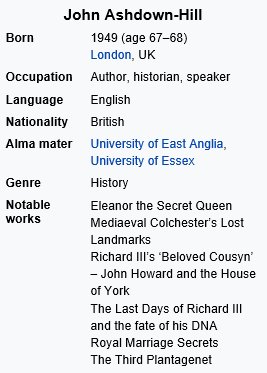
BA in History and French from University of
East Anglia
MA in Linguistics from University of Essex
PhD in medieval history from University of
Essex
|
| |
|
My
theory is that Catherine used Owen Tudor to protect
Edmund Beaufort.
Edmund
Beaufort had a considerable amount to lose. If
Catherine was pregnant and it was discovered that
Edmund Beaufort was the father, the ensuing scandal
would have cost Beaufort his political career at the
minimum, conceivably even his life or his estates. It
definitely would have guaranteed him a visit to the
Tower of London for violating that statute in some
way or another. So, if Edmund Beaufort was
indeed the father, surely he pleaded with
Catherine to protect his identity.
If so,
did this mean that Catherine needed to find another
suitor ASAP to give her pregnancy a cover story?
Given that Catherine didn't have a wide selection of
potential lovers given the tight security
surrounding her, perhaps Owen Tudor was her only
choice. Or quite possibly, she did have other
men around, but they all had money. Owen, on
the other hand, was poverty-stricken. Maybe
that worked in his favor.
|
|
|
As it
turned out, by the time Catherine gave birth to
Edmund Tudor on 11 June 1431 (a date some contest), she was heavily
involved with her new boyfriend Owen Tudor.
Catherine likely became pregnant in October 1930.
Was there a chance Catherine was still seeing Edmund
Beaufort at that time? Maybe. So let's
pretend we can read the mind of Catherine.
Call it Scenario One.
I, Catherine, am 30 years old. Recently I
broke up with my long-time boyfriend Edmund.
Been feeling kinda lonely lately and I met this
new guy Owen. He works here at the palace
keeping my wardrobe in order.
Owen is this really good-looking Welsh guy, you
know, a medieval hunk if I ever saw one. Lately
I have been distracting him from his job.
One day Owen caught me in one of those moods.
There was a spark and I lost it. Something happened.
Now I want it to happen
again and again.
But I have a big problem. I'm pregnant!!!
There is no way it could be Owen's child.
It has to be Edmund's child. I am sure of
it. In fact, I know when it happened.
Back in October, Edmund and I had been drifting apart, but
one night he came over for my birthday
party. Too much wine, not that awful
English stuff, but good French wine. You
know how it goes, he looked at me, I looked at
him and we had one more fling for old times sake.
Now look at me.
I am going to have to tell Owen about this. If the child is a boy, I
wonder if Owen would mind very much if I go
ahead and name my baby after Edmund. Are Welsh guys touchy about this sort of thing?
But you know, if I really and truly want to name
my son after my ex-boyfriend, surely Owen won't
doubt my love for him...
|
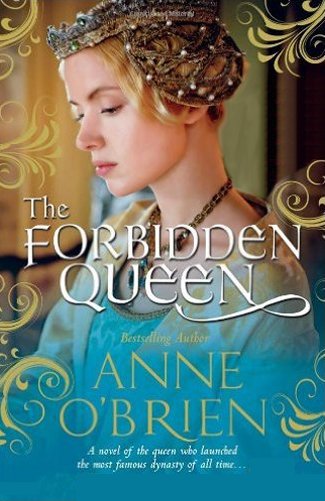 |
| |
|
Catherine claimed the baby belonged to
Owen Tudor. Let's do another scenario and
assume she is telling the truth. Call it Scenario
Two.
This thing with Owen is so special. I am
wild about the guy. Unfortunately he is
taking a real chance by sneaking into my room at
night. People watch me all the time and I
know they are suspicious. My ladies in
waiting are already onto me, I am sure of it.
This is very dangerous. Owen is breaking the
law by sleeping with me. If the wrong
people discover our relationship, Owen could be
put in prison. I am surrounded with people like
that. Sometimes I really hate my life.
Now I have another problem.
I'm pregnant. It is Owen's
child, no doubt about it, but I want to name my
baby 'Edmund'. As the former Queen, that's
my right, isn't it? I'm sure it's a boy
and I so much want to name him in the memory of
my old boyfriend. I wonder if Owen would
mind? Are guys sensitive about these
things like this?
Owen said something about wanting to name the
child after him. You know, I get it. I really do see his
point. Every dude in France and England
names his first son after himself. So when Owen brings up
'Owen Junior' or 'Owen the Second', I guess I can see
where he is coming from. But you know
what? I get so tired of all these Louies and Edwards and Henrys I could just
scream sometimes! How does a girl tell
them all apart? Stamp a Roman numeral on
their forehead, that's what I say.
The way
I look at it, if I really and truly want to name
my son after my ex-boyfriend, surely Owen won't
doubt my love for him. I will make a deal
with him. The next boy will get his name
(Note: their third son was named Owen).
For the record, I was named 'Richard' because my
uncle Richard was my mother's favorite brother.
Most women name their sons after someone they like,
someone special. In Catherine's case, there
was only one Edmund in her life. Because
Catherine was French, there were no 'Edmunds' in
Catherine's family. So I ask again... why
would she name her son 'Edmund'?
Since I
am a guy, I feel at
least somewhat qualified to offer the male
perspective here. If I found out my wife or my
hot and heavy lover was going to name her child of suspect
parentage after her old boyfriend, I would
absolutely
raise the castle roof. This is why I suspect
there could be a third scenario... one that no
website that I have come across has suggested.
We
started this chapter by asking a question:
How did a lowly Welshman bed a Queen and start a
dynasty?
The
official Henry VII propaganda story is that Henry's
grandfather was the product of a magic love affair
between a servant and a Queen. Oh, how
wonderfully romantic!! But what if that is
complete hogwash?
What if Catherine decided that taking Owen as her
lover was her only way to protect Edmund Beaufort?
|
| |
|
Think
about it. If Catherine still cared for Edmund
Beaufort, she would have to disguise the nature of
her pregnancy. Edmund Beaufort had a lot to
lose, but what did a nobody like Owen Tudor have to
lose besides his head?
The only
question at this point is how would Catherine
approach the situation. Would she sit down and
strike up a bargain with Owen in a business-like way? Would she have
the guts to openly discuss the problem and ask Owen
what he thought about giving Edmund Beaufort a cover
story?
You
know, I have to say I doubt it. I find it very
difficult to imagine a Queen would humble herself by
politely asking a servant to get involved in a very
dangerous affair. I think any legitimate femme
fatale would do it the easy way. There is a
great movie called Body Heat.
That movie makes it very clear what a good-looking
woman can get a guy to do after she has had sex with
him a few times.
All
Catherine had to do was undress and knock the
poor boy's lights out. After all, no
self-respecting Welshman could possibly resist
hitting on a naked Queen who looks like Catherine.
That's where I would place my bet. So let us
try to read the mind of Owen Tudor. Call it
Scenario Three.
Good grief, the Queen must be out of her mind!
I was trying to hang up some of her dresses in
the royal closet last night. The Queen
snuck up from behind. First she put her
arms around me, then she turned me around and kissed me.
I was pretty fearful, but she dragged me into her
bed. I tried to resist, but you know how
it is. Once the Cat Lady dropped her cloak and
told me she wanted me, I was helpless to the
heat. That is one beautiful woman.
Not only that, the Queen is insatiable.
Every time we finished, she stroked me until I
was ready to start anew. Over and over and
over again.
On the spirits of my dead ancestors, I cannot
imagine what I did to deserve this. That
woman wore me out. I can barely move today!
Catherine said she had something she wanted to
talk to me about. I wonder what it could
be...
That led to Scenario Four. I imagine that once
Owen became Catherine's lover, at some point
Catherine came to him with a distraught look on her face.
"Owen,
oh no, I am in so much trouble. I have just discovered I am pregnant!
I am so sorry, but that it can't possibly be
your child. I wish it was your child, I
love you so much, but it has be Edmund's child.
Owen, I need your help..."
So was 'Love' involved or not? Not at
first. I think this Love Story started out as
deception on Catherine's part. While Owen
thought he was part of a magic romance, Catherine
was setting up her alibi. I think once
Catherine had Owen wrapped around her finger, maybe
she offered some candor about her problem, maybe
not. Drawing upon Owen's likely infatuation, I
think Catherine persuaded him to move out of the
castle with her, move to the country and claim her child as his.
This would
give Edmund Beaufort the protection he needed.
Once Owen agreed to the scheme, maybe he quietly
resigned his job and disappeared. A couple weeks
later, Catherine told the officials she had decided
to live away from court. They reunited at her
palace in Hertfordshire
30 miles north of London. Probably no one even
noticed the two events were connected.
Catherine had her baby out in the countryside away from
prying eyes. She said the child belonged to
Owen Tudor and no one bothered to dig deeper since
Catherine stayed out of politics from that point on. The
reports say that Catherine stayed off the radar for
several years. She came to visit her son
Henry VI from time to time, but always kept it
low-key.
What
about Owen? Look at it from Owen's
point of view. If he saw things in a practical
way, he had much to gain here... a relationship with a beautiful woman, the status of marrying
the former Queen, the very real possibility their
son could be a royal someday (French royal blood),
and the considerable estate that Catherine
possessed. In other words, Owen was in the
right place at the right time to luck into something
very good. His station in life was
dramatically elevated. All Owen had to do was
swallow his pride a little.
The
evidence suggests that Owen and Catherine did
develop something special once removed from public
scrutiny. The two of the lived in the country
away from the limelight, always doing their best to
keep a low profile. During this time, they had
five children. Edmund, Jasper and
Owen, the three sons born to the couple, were all
born away from court. Out of sight, out of
mind.
|
 |
| |
|
If my
fanciful 'alternative story' is correct, we
have a very plausible answer to the question of how
a lowly Welshman bedded a Queen and started a
dynasty. It was Catherine's idea all
along!
Personally, I believe
that Edmund Beaufort is the likely father of Edmund
Tudor. I say this simply because no woman in her right mind would
insult her new lover without a damn good reason.
Since he failed to object, I contend Owen had to
know exactly what was going on!!
My
opinion contradicts the history books.
Catherine publicly stated that Edmund was the son of
Owen Tudor, so maybe Owen Tudor was the father just
like Catherine said he was.
But I
doubt it. So does historian John Ashdown-Hill,
a man with a formidable reputation.
In
addition to his doctorate in history, John
Ashdown-Hill is a member of
the Most Excellent Order of the British Empire,
a Fellow of The Society of Antiquaries, a Fellow of
the Royal Historical Society, and a member of the
Society of Genealogists, the Richard III Society,
and the Centre Europeen d'Etudes Bourguignonnes.
I would guess that this gentleman is eminently
qualified to comment on this story.
As for
my own credentials, they are non-existent in the
field of history. I fully admit I have no
credibility which explains why I have chosen to ride the
coattails of this esteemed scholar.
The bottom
line is that neither Dr. Ashdown-Hill nor I believe
the Owen Tudor-Fair Catherine Fairy Tale took place
as reported.
|
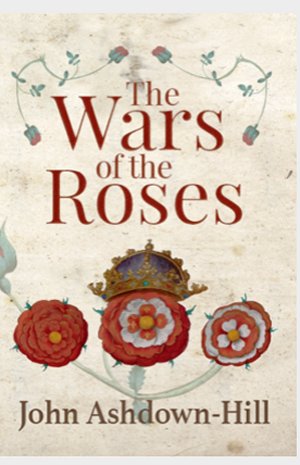 |
| |
Whatever
the truth, ultimately it doesn't make much
difference who the father was. Edmund Beaufort
or Owen Tudor, either way Edmund Tudor was
illegitimate. Harsh words, but let's get one
thing straight... there has never been any direct
evidence for the lawful marriage of Owen and
Catherine. No witness stepped forward nor did
any written record of their marriage exist.
Centuries have passed, but no one has yet to find a
time or a place of Owen's marriage to Catherine.
They were 'married' simply because Henry VI
said so when he legitimized the Catherine/Owen
children in 1452.
Ordinarily I wouldn't make such a fuss about
something as absurd as Edmund Tudor's parentage
except for the fact that we are talking about the
start of a royal dynasty here. Unsurprisingly, Henry the Seventh was
said to be extremely touchy about this
particular subject. There is a saying
that history is written by the
winners. I suspect that once
Henry VII finished rewriting the 15th century
history books, the English people were expected to
believe that his origins lie in a curious romance
that defied all common sense.
Faced
with accounts that are sprinkled with the words 'legend'
and 'about', we will never know the truth.
Catherine was
an isolated, lovelorn widow
who died without ambition
or accomplishment. She left us no
diaries, no recorded
personal thoughts, and no
interesting speeches. Her
only deeds of note were to give birth to a crazy
king, Henry VI, and an illegitimate son named
Edmund.
And that’s all history
would have known of her if not for the fact that
Henry VII's propaganda machine
worked so hard to make us believe an
astonishing tale that a Queen
would somehow stoop so low as to share her bed with
a servant based on 'love'. Yeah, nice
try, Henry.
|
Final Thoughts on Owen and
Catherine's Story
|
After I
finished writing my story about Owen and Catherine,
I found myself curious to know if there was a
different Edmund in Catherine's life that might
explain her choice of the name. I
decided to poke around a few websites and look for
another reason to explain the Edmund/Edmund name
coincidence. After a considerable amount of
time, I did find something interesting:
The name Edmund is believed to have been chosen
for Edmund Beaufort, Duke of Somerset, whom
recent unproven theories suggest was actually
his father. But a more likely explanation
is that Beaufort stood as the child's godfather
at his christening. It was a common
practice at the time to name a child after a
godparent. (source)
I was not at all satisfied with this explanation.
The explanation seemed unbearably convenient.
Edmund Beaufort would have been between 22 and 24 at
the time of Edmund Tudor's birth. Isn't that a
bit 'young' to be named as a godfather?
Would not the former queen of England be able to
find someone a bit older and more respectable to be
the child's godfather than her former boyfriend?
And how would Owen feel about her former boyfriend
being named as godfather? (Yes, we are back to
that again).
Nevertheless, I decided the explore the 'godfather'
explanation a bit further. So I went to Google and
typed in: edmund tudor godfather
Lo and
behold, I discovered a scholarly attempt to settle
the same question: Why would Catherine name her
son 'Edmund'?
The
following is an excerpt. You can read the
entire thread yourself
here.
From: "Tony Hoskins"
Subject: Edmund Tudor a (Beaufort-)
Plantagenet?
Date: Sat, 11 Aug 2007 10:54:28 -0700
I raise this matter again.
"Around 1424, rumours about her [Catherine
of France, Queen of England] connection with
Owen Tudor were heard."
The naming of their first child, Edmund
Tudor, has also led to serious speculation
on whether Henry VII, Edmund Tudor's son,
descended from Beauforts on both sides of
his pedigree."
Edmund Tudor's birth date seems vague.
Since arguably Edmund Tudor might just have
easily have been born from say about
1427-1432, his father might well have
been Edmund Beaufort, known to have
been a suitor for Queen Catherine at least
in 1427/8.
Jones also says:
"[Queen Catherine] may have taken
Tudor as her husband to prevent her true
love, Edmund Beaufort, suffering the
penalties of the statute of 1428, since Owen
had so few possessions to forfeit."
That the widowed Queen Catherine's eldest
son should be named Edmund - a
name appearing in neither the families of
Owen Tudor nor the Valois - taken in
conjunction with the chronology, the vague
dates, and the known attraction c.1427/8 (at
least) between Queen Catherine and Edmund
Beaufort is striking.
Does anyone have any thoughts or comments on
this?
Tony Hoskins
Anthony Hoskins
History, Genealogy and Archives Librarian
History and Genealogy Library
Santa Rosa, California 95404
Here are
excerpts of what Tony Hoskins' colleague
Brad Verity wrote in reply:
•
And
who else in the royal family should
stand as godfather to a son borne by the
queen as a result of a marriage to a man
of lesser social standing that was not
known to the public, or even to the
royal council? Conceivably a
number of others could be godfather.
But why Edmund Beaufort?
•
The
alternative explanation is that Queen
Catherine named her bastard son Edmund
because that was his father's name,
which seems the best way of any of
trumpeting the child's true paternity -
a stupid decision if the point was to
hide the fact.
•
The
Queen secretly marries a low-level chump
instead in order to prevent the real man
she loves from losing his lands?
•
There
is supposed to be evidence of the "hot
and heavy" relationship with Owen.
I know of none, save the abundant
mythology surrounding Catherine and
Owen. There *is* on the other hand
documentation of the Queen's passion for
Edmund Beaufort.
•
The
fact is that Catherine kept it well
hidden. Perhaps the "secret
marriage" to Owen Tudor was kept
purposely murky as to specifics because
it covered up the fact that her son
Edmund was born illegitimately to the
Queen and Edmund Beaufort, and that the
clandestine nature of her subsequent
marriage to Owen - after the fact of
Edmund "Tudor's" birth - allowed for
cover.
•
The
case for Edmund Tudor being Edmund
Beaufort's son is plausible on many
levels.
From: "D.
Spencer Hines"
Subject: Re: Edmund Tudor a (Beaufort-)
Plantagenet?
Date: Sun, 12 Aug 2007 09:40:01 +1000
Desperate, Rampant
Speculation.
Amusing...
Rick Archer's Note:
I have
mentioned this thread to show that I am not the only
one who finds the matching Edmund names to be
disturbing. The thread makes it clear that the
Edmund Tudor-Edmund Beaufort parentage question is
considered a very real possibility in scholarly
circles. And yet at the same time, D. Spencer
Hines readily dismissed the entire thought.
Hines later added that 'Tony [Hoskins] is living
in Fantasy Land'.
Whatever
the truth here, something remarkable did appear to
take place between Catherine and Owen after they
left the castle.
As a poignant
footnote to this story, Owen and Catherine had six happy years together
(1430-1436). Unfortunately,
their quiet life came to an end in 1436.
Catherine was pregnant with her fifth child by Owen
Tudor when rumors of the Queen's secret marriage
reached the ear of Humphrey, Duke of Gloucester, the
ever-present villain in this story.
Humphrey
immediately had Owen
imprisoned on a charge of treason. Deeply
distressed and traumatized at the forced separation
from her husband and children, Catherine went to
Bermondsey Abbey to have her child. Shortly
after giving birth to their daughter Margaret,
Catherine fell gravely ill and died quickly.
She was 35. There are reports that she died in
disgrace. No mention of her marriage to Owen
Tudor was made on her gravestone.
Upon Owen's
arrest, the queen believed there was no chance of
reuniting. Without hope, some say Catherine died
because she wanted to.
As it turned
out, the Queen was wrong. Several years later,
Owen Tudor was released. Sad to say, he became
an early casualty in the Wars of the Roses.
Owen joined his son Jasper's army in Wales in
January 1461, a force which was defeated at the
Battle of Mortimer's Cross by Edward of
York (Edward IV). Owen Tudor was captured and
beheaded following the battle.
Moments before
his execution, Owen murmured, "my head shalle ly on
the stocke that was wonte to ly on Quene Katheryns
lappe."
I have
suggested that Catherine may have exploited Owen in
the beginning to provide cover for Edmund Beaufort.
Whether this is true or not is anyone's guess.
What I am touched by is the evidence that these two
people went to their death loving each other
intensely.
The expression
'epic, earth-shattering love affair' may not
have missed the mark after all.
|
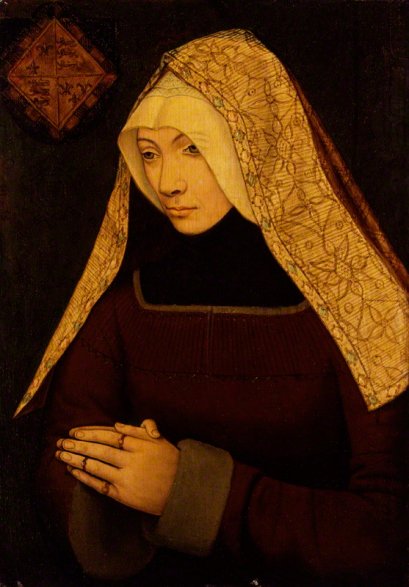 |
Margaret Beaufort,
the Red Queen
Margaret Beaufort was the Red Queen of
Lancaster to
Elizabeth Woodville's White Queen of York
during the War
of the Roses. During Act One and Act
Two, the two women
were on opposite sides, but would become allies
late in the game to help bring down Richard
III, the villain of Act Three.
Margaret
would marry Edmund Tudor, the much-discussed
illegitimate son of Owen and Catherine.
Together they produced Henry Tudor, the
man who would one day become King Henry VII, the
first ruler in the Tudor Dynasty. In many ways,
Margaret Beaufort's passion to advance her son
Henry Tudor to the throne matched that of her predecessor Margaret of
Anjou in regards to her son Edward. Margaret
B. would stop at nothing.
Margaret
Beaufort was a direct descendant of King Edward III
through his son John of Gaunt. There is a
chart below to help follow my narrative.
John of
Gaunt had a wife, Blanche, and a
mistress, Katherine Swynford.
Through
Blanche, John was the forefather of three kings:
Henry IV (Bolingsbroke), Henry V
of Agincourt fame, and Henry VI whose
madness caused the War of the Roses. When
Edward, son of Margaret of Anjou, died at
Tewkesbury, this line died out.
John of
Gaunt produced a second line through
Katherine Swynford, his mistress whom he
married late in life. Her three children were
illegitimate, but later legitimized by King Richard
II in 1390.
John Beaufort, the First Earl of Somerset,
had two sons. His oldest son, John Beaufort,
the First Duke of Somerset, had only one child...
Margaret Beaufort. His second son,
Edmund Beaufort, the Second Duke of
Somerset, is the one who caused all the trouble.
Edmund had three sons, all of whom died fighting in
the War of the Roses. Edmund Beaufort also had
two illegitimate sons. One, Edward by Margaret
of Anjou, died fighting at Tewkesbury.
|
|
|
|
The other illegitimate son, Edmund
Tudor, married Edmund Beaufort's
niece Margaret Beaufort to
produce Henry Tudor. If one believes
that Edmund Beaufort was Edmund Tudor's
father, then Edmund Tudor was Margaret's
first cousin, in which case the royal house of ‘Tudor’
sprang in fact from Beauforts on both sides.
This would be very ironic. Edmund
Beaufort, the leader of the House of
Lancaster, was the big loser during the War
of the Roses. In addition to getting
himself killed, his three sons were killed,
his son-in-law was killed, his grandson was
killed, and one of his illegitimate sons was
killed. Through his family's pursuit
of the throne, the entire male line of the
Beauforts was extinguished.
Now only Edmund's niece Margaret Beaufort
was left, which explains how she became the
head of the House of Lancaster. Thanks
to Margaret, Edmund Beaufort's bastard son
Edmund Tudor found the Tudor Line. In
order words, Edmund Beaufort's ambition eradicated the
House of Beaufort, but he also secretly
started the House of Tudor. Very
curious.
As one can
see, the future Henry VII was born
with a claim to the English crown which was
threadbare and
ridiculously complicated.
So let me simplify things... his mother
Margaret Beaufort would
supply enough royal Plantagenet blood to allow
her son
Henry to become king in 1485.
In my
opinion, Margaret Beaufort was the most remarkable
woman of her era. She was blessed with talent
and tremendous wealth, yet had to overcome
unbelievable hardship to finally take control of her
life.
Despite being one of the
wealthiest women in England, Margaret
Beaufort (1443-1509) went from a position of
complete powerlessness to
one of almost total power.
We
already know that Margaret was a direct descendant
from the wealthy family of John of Gaunt. As
the first son of her grandfather John Beaufort,
Margaret's father John Beaufort inherited vast
estates as the Duke of Somerset.
John
Beaufort had endured 17 years as a prisoner of war,
the longest imprisonment of any English aristocrat
during the Hundred Years War. By the time of his
release, John was an embittered man, broken in both
body and spirit, heavily in debt. Beaufort
returned to England long enough to sire Margaret,
his only child, but then was immediately
ordered to return to France for more fighting.
|
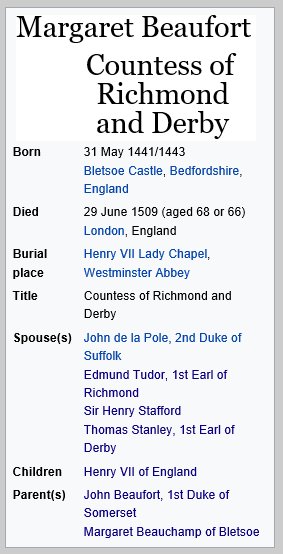 |
| |
|
|
Margaret
never knew her father. At the
moment of her birth, her father was preparing
to go to France to lead an important military
expedition for King Henry VI. Beaufort
negotiated with the king to ensure that in case of
his death the rights to Margaret's wardship and
marriage would be granted only to his wife Margaret
Beauchamp. (Under English law, as a
tenant-in-chief of the crown the wardship of
Beaufort's heir fell to the crown under the feudal
system.)
|
| |
Alas,
Margaret's father was a notable failure as a
military commander just about the time Margaret was
born. His blunders in France contributed
directly to the loss of many French territories
towards the end of the Hundred Year's War.
John Beaufort fell out with the king after coming
back from France and was banished from the royal
court pending a charge of treason against him.
He committed suicide shortly afterwards in 1444.
John
Beaufort was not the only failure. His brother
Edmund Beaufort had failed even worse. The
lasting effect of the two Beaufort failures was burning
resentment between the House of York and remaining
members of the Beaufort family. This would
create the intense rivalry between Edmund Beaufort
and Richard of York that led to the War of the Roses
in 1453.
Margaret, as an only child, was heiress to her
father's fortune. Upon her first birthday,
King Henry VI broke the arrangement with Margaret's
father and granted the wardship of her extensive
lands to William de la Pole, 1st Duke of Suffolk,
although Margaret herself remained in the custody of
her mother Margaret Beauchamp. Margaret knew
happiness in her mother's home for three years, but then
she was yanked away.
Apparently Margaret's mother Margaret Beauchamp did
not have much say-so in the matter of her own
daughter. Incredibly, at age 4, Margaret was
taken away to live with William de la Pole and his
wife. Two years later, Margaret was married.
Yes, you read that correctly. Before his
death, William de la Pole managed to arrange the
marriage of his young ward Margaret to his son, John
de la Pole. Margaret was six years old!!
Her groom was an older man, seven. The reason
for the marriage? De la Pole had been arrested
and was looking to secure his son's future.
Imagine being six and married.
In 1449,
Henry VI dissolved this sham marriage and granted
Margaret's wardship to his own half-brothers, Jasper
and Edmund Tudor. Margaret was 8. Her
two new 'parents' Edmund and Jasper were
teenagers only about 10-12 years older than she was.
|
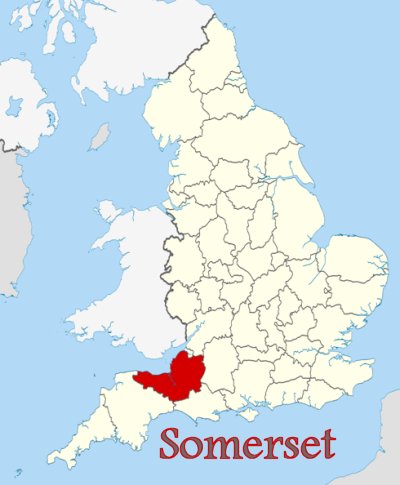 |
| |
|
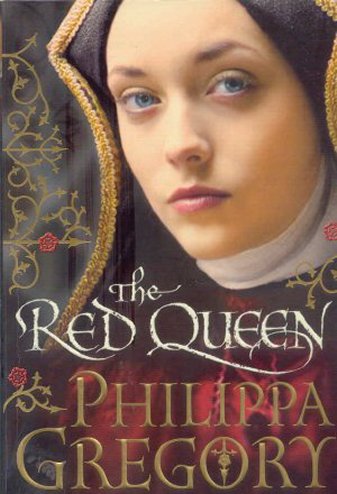 |
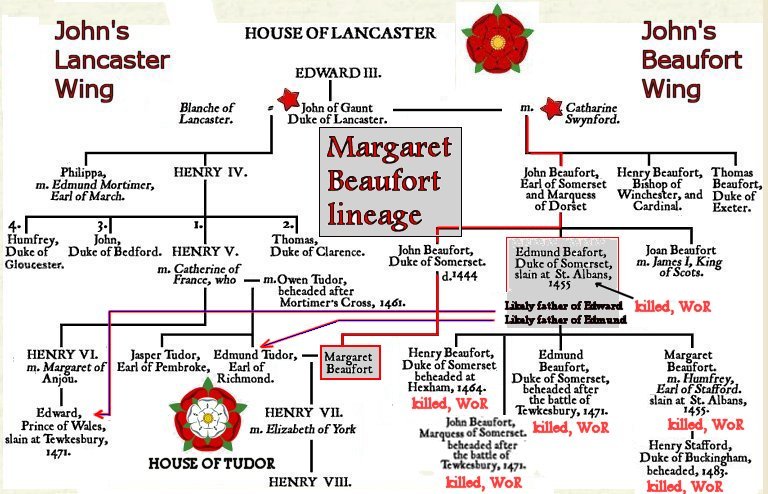 |
Edmund and Jasper
Tudor
Edmund
and Jasper Tudor were born five months apart in
1431. Or so Wikipedia says. Wikipedia
lists Edmund's birthday as June 1431 and lists
Jasper's birthday as November 1431. The truth
is that all these birthdays are guesses. If
indeed Edmund Beaufort was really Edmund Tudor's
father, Edmund could have been born anywhere from
three to four years earlier. No one really
knows.
Thanks
to their mother Catherine, Edmund and Jasper were
half-brothers to King Henry VI who was approximately
ten years older.
Henry had
no idea of their existence until 1436. There
was a good reason for that... Catherine kept the
existence of her family a secret to avoid
persecution. It didn't work. In 1436,
someone informed Humphrey, the Regent, about
Catherine's family.
Owen Tudor
was arrested and sent to Newgate prison.
Catherine died at Bermondsey Abbey a few months
later as a consequence of giving birth to her
daughter. On her death bed, Catherine told
Henry the whole story.
Owen
Tudor was released from prison in 1439 thanks to
Henry VI. Henry granted him a general pardon,
restoring his goods and lands
At his
mother's dying request, Henry would also begin to
care for the children. Jasper, Edmund, and
possibly their sister were put into the care of
Katherine de la Pole, a nun at Barking Abbey, in
Essex, from 1437 to 1442. The de la Pole
family was a great favorite of Henry VI.
Katherine was the sister of William de la Pole, 1st
Duke of Suffolk, the family that was caring for
Margaret Beaufort. As one can see, the de la
Poles were the connection that bound the fortunes of
the Tudor boys and the Beaufort girl together.
In 1442,
Henry VI, now 21, began to take a greater interest
in the boy's upbringing. Jasper and Edmund
were brought to live at court. Henry arranged for
the best priest to educate them intellectually and
morally. The brothers also received military
training; when they grew up they were given military
positions. During this time, Henry grew very
fond of the two boys and trusted them.
In 1445,
Henry VI married Margaret of Anjou. Margaret
was more or less the same age as the two boys.
The three of them got along just fine.
Margaret could see they had her husband's best
interests at heart. In addition, they had no
blood ties to the English throne, so they were not a
threat.
In 1452,
incredibly, Henry VI interfered with Margaret
Beaufort's life again. William de la Pole had
come into great disfavor with Henry, so Henry
decided to grant
custody of Margaret to his two half-brothers, Edmund,
21,
and Jasper Tudor, 20. Now that Henry VI had
come of age, he had the power to give earldoms to
both brothers. Jasper became Earl of Pembroke 1n
1452 and Edmund became the First Earl of Richmond.
In turn, Edmund, 23, and Jasper, 21, gave Henry
unwavering loyalty. They fought for the Lancasters and promoted Henry's
interests unwaveringly throughout their lives.
|
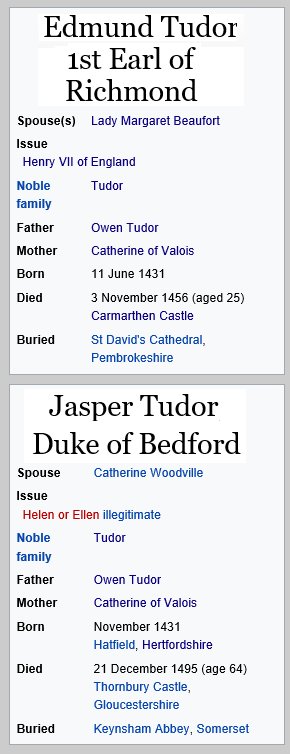 |
| |
1453 was
the year all hell would break loose in England.
England lost the Hundred Year's War, Margaret of
Anjou was pregnant with Edmund Beaufort's
illegitimate child, Henry VI collapsed into a
catatonic state, and Richard of York was pushing
hard to be named the heir presumptive of England.
In 1453
William de la Pole fell into disfavor. Shortly
before his 1453 descent into madness, Henry
VI dissolved Margaret Beaufort's first marriage and made her
a ward of Edmund and Jasper with the understanding
that Margaret, 9, would marry his half-brother
Edmund went she grew old enough at age 12.
In March 1453, Edmund and Jasper were given joint
custody of Margaret Beaufort, heiress of the Duke of
Somerset.
Two
years later England was now embroiled in civil war. Margaret
was 12 when she married the 24-year-old Edmund Tudor
on 1 November 1455. The Wars of the Roses
would cast a dark cloud over their
marriage. About four months after the wedding,
Edmund was sent to uphold the authority of the King
in South Wales. While he was there, Richard of York
was overthrown by the re-awakened King Henry.
In retaliation, Yorkist forces were sent to engage
those of Edmund Tudor in South Wales. Edmund
was captured at Carmarthen Castle. He would
die in captivity of bubonic plague on 3 November
1456.
Margaret
was seven months pregnant with their child when
Edmund died.
Taken into the care of her brother-in-law Jasper at
Pembroke Castle, the Countess gave birth on 28
January 1457 to her only child, Henry Tudor, the
future Henry VII of England. The birth was
particularly difficult due to
her young age and small size. At one point, both the
Countess and her child were close to death
Margaret would never give
birth again. In fact, sex was so painful that
Margaret could barely stand the thought. At
13, an age when some girls were still playing with
dolls, Margaret was widowed with a baby boy and
living in Wales, a rough and tumble world akin to
living in the Wild, Wild West.
|
Henry Stafford
Keep
these three dates in mind: 3 November 1456.
28 January 1457. 6 April 1457. Unless my
math is wrong, each date is about two months apart,
yes? Husband dies, child is born, next
husband begins.
Margaret
was forced to marry at age 6, a thought our modern
minds find inconceivable. Her next experience
was marriage at 12 to a man twice her age and twice
her size. That marriage was a nightmare.
First her new husband practically ruptured her
having sex at too young an age. Then she
discovered Edmund was dead one year after the
wedding. Two months later she gave birth, an
act that left her physically damaged in child birth
and psychologically scarred.
Margaret
was understandably terrified of being stuck with
another husband against her will. So Margaret
took matters into her own hands. Before her
child was even born, Margaret was already searching
for her next husband. Margaret set her eyes on
Henry Stafford, 32, the younger son of the Duke of
Buckingham. It was a shrewd choice, a political
transaction, not a personal one. It was also a
really gutsy move.
|
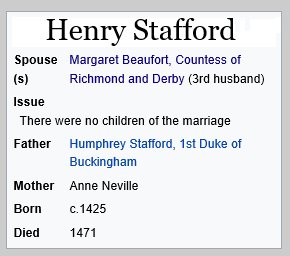 |
| |
|
To
request this marriage, Margaret was supposed to get
permission from Humphrey Stafford, Henry Stafford's
father. This meant a 13 year old girl went to
see a 54 year old man to ask if she could marry a 32
year old man. One can only wonder if she
waited till her child was born to go ask. Does
anyone besides me see the humor in this??
Humphrey
Stafford was not just the powerful Duke of
Buckingham, he was the most important member of the
Lancastrian court. This meant Margaret, age
13, 5 feet tall, 90 pounds, was meeting a 54
year-old peer of the realm to propose a marriage.
Mind you, these were the days when men ran the show.
Yet frail Margaret, a remarkable teenager to say the
least, was going toe to toe with one of England's
big shots. No doubt Margaret's confidence was
assisted by the fact that she was a wealthy heiress
of royal blood.
The Duke
of Buckingham approved her offer. However,
there was one problem... they were second cousins,
so they needed a special dispensation in order to be
married. The approval came through on 6 April
1457. This date took place just two months
after Margaret gave birth on 28 January 1457.
The Countess had endured a rough childbirth, being
close to death after childbirth. Nevertheless,
Margaret bounced back quickly. She got off her
death bed and immediately landed her next husband.
Impressive.
Incidentally, before I take this story any further,
let me warn the reader of an impending deluge of
identical names. It took me an hour just to
figure out there were two different Margaret
Beauforts existing side by side. Both
Margarets had Beauchamps for mothers and both
Margarets married Staffords. Talk about
confusing!
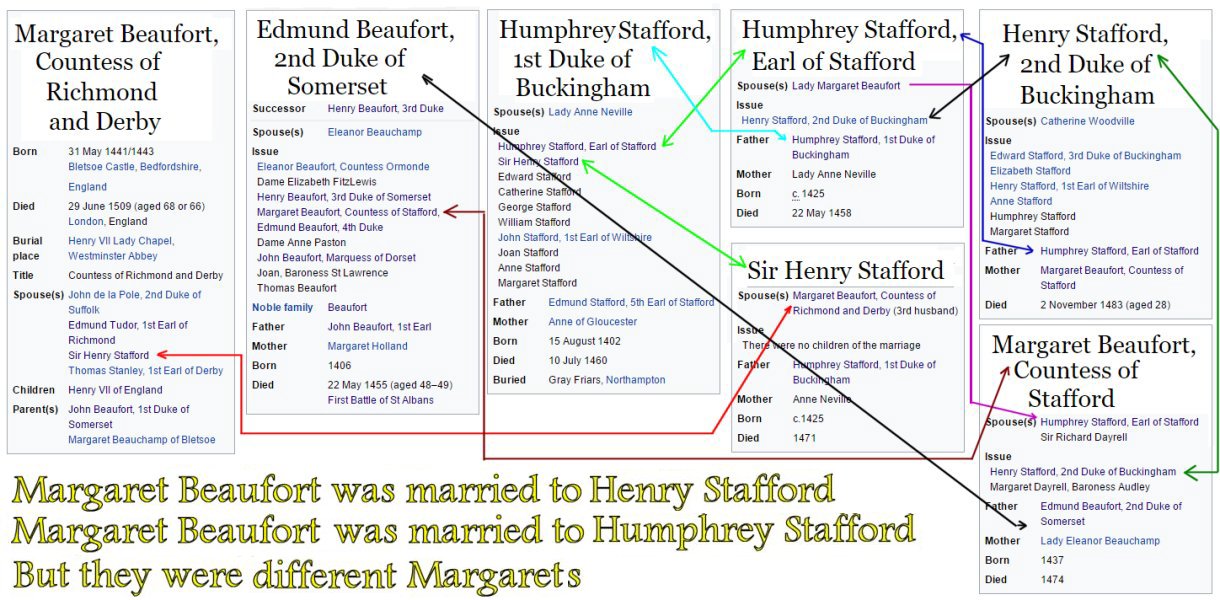
|
There
was quite a bit of irony in Margaret's marriage to
Henry Stafford... a special dispensation was
required for the marriage of Margaret Beaufort and
Henry Stafford because they were second cousins.
What was funny here is that previously Margaret Beaufort had unknowingly married
her first cousin Edmund Tudor.
Let us
not forget that Edmund Tudor potentially carried the
madness of French king Charles VI. With all
this inbreeding, no wonder there is so much madness
in the English line. Thank goodness for all
the illegitimate children. Otherwise there
would never be any fresh blood.
After the
dispensation was granted, Margaret and Henry were
free to marry. On 3
January 1458, Margaret married Sir
Henry Stafford (1425–1471), son of Humphrey
Stafford, 1st Duke of Buckingham.
However,
her new marriage caused Margaret great heartache.
Margaret was forced to leave her baby son Henry
behind at Pembroke Castle to go live with her new
husband. Jasper stayed behind to care for the
baby boy not quite one yet.
|
|
|
|
At the
time Margaret married in 1458, the War of the Roses
was at its most bitter stage. The eventual
York triumph in 1461 would bring changes to baby
Henry's life.
Control of Pembroke
Castle passed to Lord William Herbert which meant
Henry's Lancaster uncle Jasper was forced into exile
while baby Henry stayed behind. Since
the wardship of Henry Tudor had been given to Lord
Herbert, by law Henry was now living with a new family at
Pembroke Castle in Wales.
|
 |
|
|
|
No doubt the
little boy was
bewildered... no father, no mother, no uncle, raised
by strangers. Fortunately Henry was treated
well by his new family. In addition, Margaret was allowed to see him
occasionally. Still,
it broke her heart to know her
son was growing up without her care.
The War
of the Roses would cost the Stafford family
immensely.
Margaret's husband Henry lost his brother Humphrey to Richard of York in
the 1458 Battle of St. Albans. His father Humphrey
died in the pivotal 1460 Battle of
Northampton to Warwick.
In 1483,
Henry's namesake nephew would die in a lost cause
known as Buckingham's Rebellion. Henry himself
and his other brother John would both die in 1471 in
battles trying to help Edward IV regain his throne.
As one
can see, in a manner similar to America's Civil War,
the War of the Roses took an enormous toll of it
own.
|
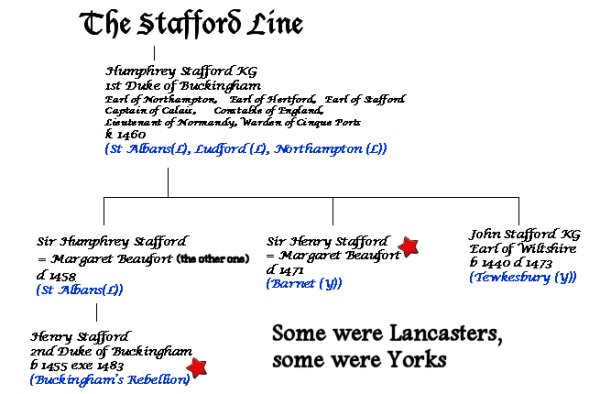 |
|
|
Edward
IV, a York, was the new king, so Margaret, a
Lancaster, had to adjust. Margaret had shown
that she was a pragmatic woman. In order to
safeguard her fortunes, she and her husband Henry
Stafford sought a rapprochement with Edward who
fortunately was in a forgiving mood. There
are mixed accounts of Margaret's 13-year marriage to
Henry Stafford. On the one hand, Margaret and
Henry were said to spend a great deal of time
together. The evidence of the Stafford household books shows
that the couple rarely left each other's company,
touring their estates and attending parliament
together.
Thanks
to Margaret's estate, money
was not a problem, but in a way it was.
Henry Stafford had no title, but he did have some
land. Henry was given 400 marks' worth of land
by the Duke of Buckingham. This paled in
comparison to Margaret's vast estates.
Strange
as it must seem, this 13 year old girl dominated her
32 year old husband from the very start.
Stafford was a passive, gentle man. Margaret
got her way in virtually every dispute.
Three
years after they were married, the Yorks came into
power. Margaret was a Lancaster by birth.
So was Henry Stafford. The couple did their
best to come to terms with the new Yorkist
dynasty. Henry
enjoyed close access to Edward IV, frequently
hunting with him in Windsor park. Henry
and Margaret took advantage of the proximity
of the King to entertain him at their hunting lodge
at Brookwood. Margaret had
risen
high enough in the King’s favor that they even
entertained him at their home, always a huge
undertaking. What
must have been going through Margaret’s head as she
wined and dined the man who was responsible for so
many deaths in her family?
Henry
Stafford seemed exasperated with Margaret much of
the time. To begin with, Margaret was
extremely pious. Her religious tendencies made
it difficult for Henry to deal with her sense of
righteousness. Every time he turned around,
Margaret was explaining why he had to do something
because it was 'God's Will'.
The real
strain in their marriage came when Margaret began to
talk fervently about the day her son would become
king. Margaret claimed to have had a vision
that her son would one day become king. With
no other children a possibility due to Margaret's earlier
childbirth injuries, Margaret began to obsess about
Henry.
Margaret, with her deep faith, believed that it was
always God’s plan that Henry should be king.
Unfortunately, this kind of talk was treasonous
in a time when mercy was in short supply.
Stafford was torn between his obvious concern for
his wife's well-being and his annoyance at her
fanatical nature, given that he supported the Yorkists despite his wife's
strong (and hidden) loyalty to the
Lancasters.
Fortunately, Margaret had the sense to keep her radical talk inside
the family walls. She wisely kept a low political profile during
her 13-year marriage to Henry Stafford.
In 1470,
Warwick and Margaret of Anjou had made their deal
with the Devil. Warwick's surprise rebellion
caught King Edward totally flat-footed. Edward
barely escaped to Flanders while his wife Elizabeth
Woodville took their children and fled to
Westminster Abbey for sanctuary. The
Lancasters were back in charge.
One year
later, in 1471 Edward staged his counter-attack.
Margaret's husband Henry Stafford suffered serious
wounds at the Battle of Barnet while fighting for
the victorious Yorkist side. Henry died of his wounds
shortly after. Margaret could not decide
whether she was sad or glad. Henry Stafford
had always been good to her, but she what she really
wanted to do was focus on her son's destiny.
|
There was a strange
consequence emanating from the 1471 Battle of
Barnet and subsequent Battle of Tewkesbury... the leading Lancaster
men were dead!!
The
secret pillow-smother execution of
Lancaster
King
Henry VI shortly thereafter
left
Margaret Beaufort and her son
Henry Tudor as the senior
representatives of the House of
Lancaster.
With the
male line of the House of Lancaster extinct,
Henry Tudor claimed to be the Lancastrian heir through his
mother Margaret Beaufort. In
addition, Margaret reminded everyone that her son's father
Edmund was the
maternal half-brother of Henry VI.
However,
at this
point (1471), Yorkist Edward IV was securely
established on the throne. Henry Tudor, now
14, and Jasper Tudor were Lancasters, so they wisely went to Brittany,
France, in
exile.
Meanwhile, back in England, Margaret prayed for her
son Henry. Someday Henry might
have an outside shot at the throne!
|
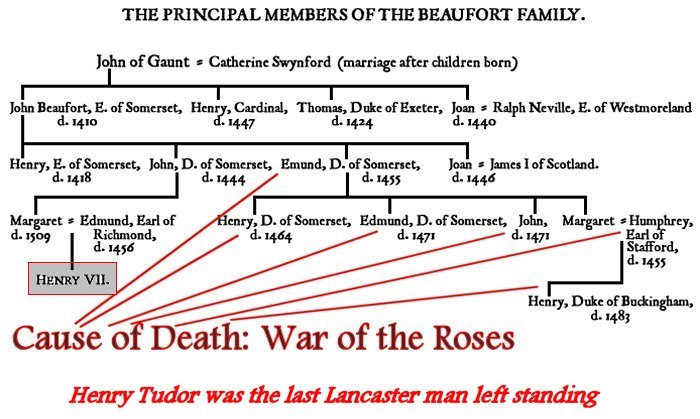 |
|
Henry Tudor
The White Queen
was a ten-part
British television drama which
told the War of the Roses from the female
perspective.
The series
was based on Philippa Gregory's
historical novels The White Queen, The Red Queen,
and The Kingmaker's Daughter.
It explained how three relentless women - Elizabeth
Woodville, Margaret Beaufort, and Anne Neville -
vied to put their sons on the throne in 15th Century
England.
Margaret
Beaufort
left Pembroke Castle when she married
Henry Stafford in 1458. Her departure came just 28 days after giving
birth toher baby boy. This picture shows a scene in the TV series when young Henry
barely knew his own mother when Margaret came to
visit. Margaret was beside herself with misery
at being separated from Henry, but there was little she could do about
it.
I have
to say that the White Queen series
brought things to life in ways that
are far superior to reading the dry Wikipedia
accounts of the same events.
The
TV series was fascinating, but it was also
ridiculously confusing. There were so many
characters I could not keep track of them all...
sort of like my story, right?
I will say, however, I always knew who Margaret
Beaufort (Amanda Hale) was. Margaret
dominated every scene thanks to her religious zeal
and fanatic determination to
promote her son to the throne.
Young Henry had
to struggle his entire childhood. Like his
mother, Henry Tudor never knew his father. In 1456,
Henry's father Edmund Tudor was captured while
fighting for Henry VI in South Wales against the
Yorkists. He died in Carmarthen Castle,
three months before Henry was born. Edmund's
brother
Jasper Tudor, Earl of Pembroke, undertook to
protect the young widow Margaret, who was 13 years
old when she gave birth to Henry in 1457.
The
second picture is amusing because it reveals that
Margaret, 42, a child bride, was young enough for
her son, 28, to date. But let's not go there.
Henry
spent his youth
negotiating danger caused by the nightmare
politics of the unending Wars of the Roses.
Fortunately, Henry always seemed to have Jasper, his
loyal uncle, at his side
for protection. Jasper was a godsend.
When the
Lancasters were in power, Henry and Jasper were safe
because King Henry VI was Jasper's half-brother.
But when the Yorks were in charge, Jasper was in
danger. Therefore when Edward IV overthrew
Henry VI in 1461, Jasper Tudor went into exile
abroad, but Henry stayed behind at Pembroke Castle.
The Earldom of Pembroke was granted to the Yorkist William Herbert, who
now assumed the
guardianship of the young Henry, 4.
Talk about feeling orphaned!
Young Henry had never known a father and had been
parted from his uncle and mother as well.
Fortunately, the Herberts seem to
have treated the boy kindly and had given
him gentleman's
education.
Henry lived in the Herbert household for 8 years.
In 1469 Richard Neville, Earl of Warwick, the
Kingmaker, double-crossed and went over to the Lancaster side.
Lord Herbert was captured fighting for the Yorkists
and executed by Warwick. There was a terrible
scene where young Henry had to watch his guardian
Herbert beheaded. Fortunately the boy himself was safe
because Warwick was fighting for the Lancasters.
When Warwick restored Henry VI to the throne
a year later
in 1470, Jasper Tudor returned from exile and
brought Henry Tudor to royal court. However,
Henry VI's reinstatement lasted only a year until Edward
IV's comeback.
During
Edward's comeback, following the Battle of Barnet,
Henry
had returned
with his Uncle Jasper
to Pembroke Castle. It was Jasper that
Margaret of Anjou had been so desperately trying to
reach when Edward chased her down at Tewkesbury.
This battle affected Henry Tudor in a strange way.
John Beaufort died in
the fighting at the 1471 Battle of Tewkesbury.
John's older brother Edmund Beaufort II
took refuge in
Tewkesbury Abbey. He was soon forced from
sanctuary and executed. Since the
Beaufort brothers died unmarried, "the house of Beaufort
and all the honors to which they were entitled
became extinct".
In other
words, Tewkesbury was the 'end of the line'
for the House of
Beaufort, at least on the legitimate male side.
Margaret Beaufort and her son
Henry were now the senior representatives of
the House of Lancaster.
The secret execution of King Henry VI
came a week later in the Tower of London. His
death left Henry
as the main threat to Edward IV. Henry did not have much of a claim to
the throne, but his pedigree... son of a woman who
descended from royalty, son of a man who descended
from the former
queen... was upsetting to the Yorkists.
This explains why Henry, 14, was forced to begin living in exile in France for
his own safety. Sensing
Edward would come after them,
Jasper and Henry narrowly escaped a forming
siege by the Yorkist army
at Pembroke
Castle. They managed to
sail to Brittany in
1471.
With Yorkist King
Edward IV back on the throne, Henry Tudor was now a
marked man. Since it was not safe for him to
return to England, Henry would not see his mother
again for 14 years. During this period, the relationship between mother
and her only son was sustained by letters.
Brittany
had become something of a Lancastrian refuge.
Henry, Jasper, and a band of Lancaster loyalists
spent the next 14 years under the protection of
Francis II, Duke of Brittany, while Henry waited for
an opening.
Duke
Francis protected
Henry from England's Yorkist king, Edward IV, who wanted
him in his own hands. Louis XI of France also tried to
get Henry into his clutches. It was
such a desperately
insecure situation that Henry
developed sharp instincts to survive. The
young Tudor grew to manhood cautious, prudent and deeply
reserved. This was good because
Henry would need his wits to save him from danger three
times in the coming
years.
The
first escape came in
November 1476.
When Francis, Henry's protector, fell ill, his principal advisers
negotiated with the English king. Henry was handed over and escorted to the Breton
port of Saint-Malo.
While
there, Henry feigned stomach cramps. In the
confusion, Henry fled into a monastery. Edward
IV ordered his extraction with the intention of
executing the lad, 19. However, the
townspeople took exception to this strong-arm
behavior and alerted Duke Francis. He
recovered from his illness long enough to send a
small band of scouts to rescue Henry.
This had
been a close call. There would be others.
|
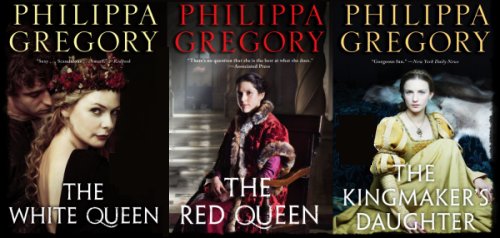
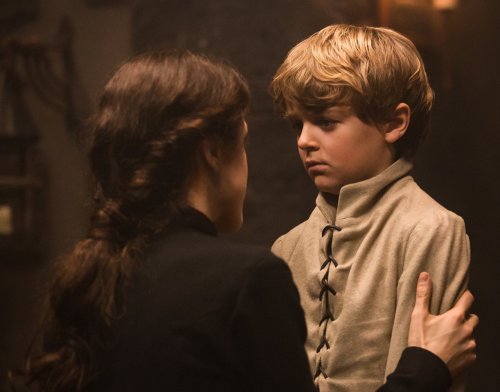
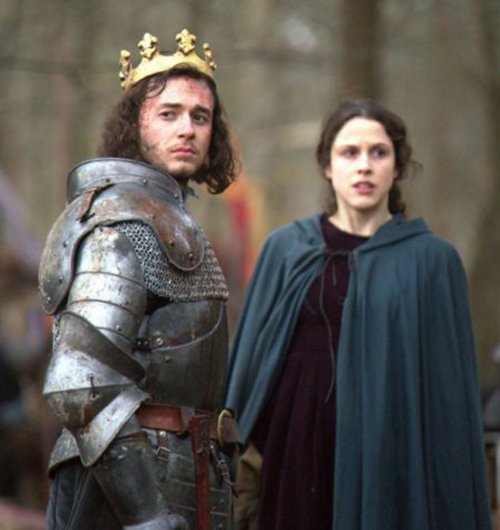

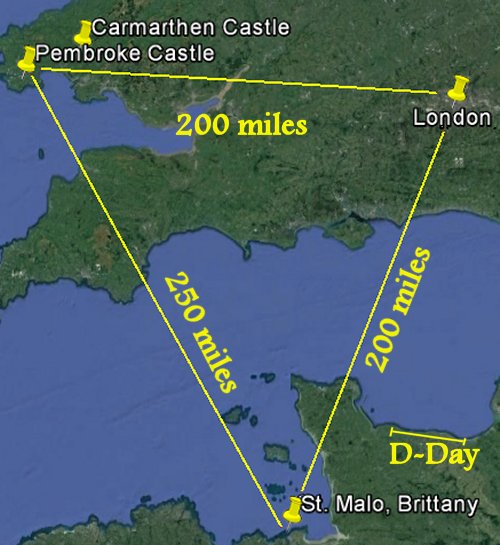 |
Following Henry Stafford's death,
Margaret, 28, was a widow again, but not for long. One year
later she remarried. Margaret wanted to begin
playing politics, but she needed a ticket to enter
the rarified circles of the Royal Court.
She set her sights
on
Lord
Thomas Stanley. Stanley, 36, was a landed
magnate of immense power, particularly across the
northwest of England where his authority went almost
unchallenged, even by the Crown.
Stanley was one of the
most successful power-brokers of his age. As
testament to his gift for negotiating the
treacherous climate, Stanley managed to remain
in favor with successive kings throughout the Wars
of the Roses. That in itself speaks to
Stanley's considerable wisdom.
Stanley's first wife was Eleanor Neville, sister of
Richard Neville, the Kingmaker. This marriage
in the late 1450s constituted a powerful alliance
with the House of York. Then tragedy struck.
Eleanor died of natural causes in
1471, the same year Margaret lost her husband.
Margaret
made a shrewd political move when she decided to
chase Lord Stanley. Margaret had just targeted
the most powerful and trusted supporter of the
ruling Yorks to be Husband number three.
She wanted a man who was clever enough to see that
her son might have a chance at the throne one day
and duplicitous enough to serve two sides at once.
She
found her perfect partner in Thomas Lord Stanley.
But why would he be interested in her??
As it
turned out, Thomas Stanley, 36, was a businessman
who loved to explore opportunities. Stanley
was very intrigued by this small, intense woman from
the opposing side of the fence.
|
 |
| |
|
Stanley,
a man of considerable acumen, was a game player of
sorts. He had a theory that the only way to
win all the time was to place a bet on both sides.
In this case, Stanley, a Yorkist through and
through, had just been offered the chance to team up
with a wealthy, well-connected member of the
Lancaster family. In a country where political
change took place with mercurial speed, no doubt
Margaret would come in handy because she would
provide protection from any Lancaster developments.
In addition, she had this kid of hers as a Wild
Card. The birthright of her fugitive son might
just prove useful as well.
|
| |
|
Stanley
lacked for nothing... he had three male heirs,
plenty of land, and a strong relationship with the
crown. What Stanley lacked was a challenge.
When Margaret pointed out her son had a shot at
becoming king, Stanley just laughed.
"Margaret, there are five men between your son and
the crown - Edward, George, Richard, and Edward's
two sons. More heirs could be born. The
chances of your Henry getting a chance are very
remote."
"Yes, Lord Stanley, but I have been given a
vision. Don't ask me to explain it, but I
have a strong belief in my heart that Henry is
meant to be king. I want you to help me."
Stanley
was amused. A marriage to this unusual woman
might prove interesting.
Stanley was
not interested in a wife for romantic reasons, but
rather for political reasons.
The marriage settlement, drawn
up in June 1472, was a careful
business arrangement of mutual
benefit.
The risk
was low and the potential benefits were high. Two of
England's
wealthiest figures had just teamed up.
Stanley got to work immediately.
With Stanley's assistance,
Margaret was able to consolidate her landed estates.
In addition,
Stanley introduced Margaret to
the
enemy. Lord Stanley's influence enabled her to
enter the royal court of Edward IV and Elizabeth
Woodville. To Stanley's surprise and further amusement, Margaret
blended in and became very well liked.
Margaret was so liked
in fact that Queen Elizabeth chose her as a
godmother for Bridget of York, one of the princesses.
The War
of Roses had taken its toll. After the death
of so many leading Lancaster men, Margaret was now
the most powerful Lancaster woman in England.
Her
new Yorkist connections might seem to contradict Margaret as a committed Lancastrian,
but Margaret was deliberately courting favor on both
sides. Margaret was
building a power base.
Warwick
the Kingmaker had once been Lord Stanley's
brother-in-law. Margaret wanted to be the next
Kingmaker. Her first step had been to gain
this alliance with a powerful man. To her
delight, Lord Stanley got a kick out of watching her
go to town.
|
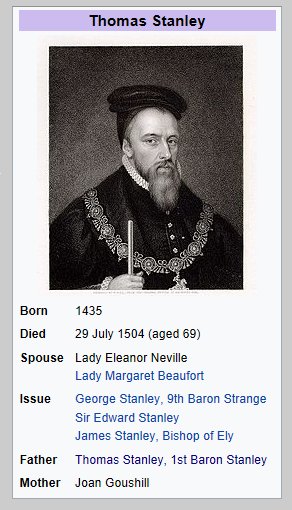 |
| |
During
the twelve year lull in fighting between Edward IV's 1471 victories
and his death in 1483, Margaret used this
time to learn how to negotiate the world of political affairs.
Her dominant
characteristic was her political astuteness rather than
blindly partisan allegiance. Margaret's
way was to make friends and gain consensus through
contacts and favors. If the day ever came for
her son Henry to make his move, these alliances
would come in handy. Stanley approved.
As he had guessed, watching this tiny, absurdly
pious woman in action was like looking at himself in
a mirror in oh so many ways. Margaret was a
woman after his own heart.
|
| |
|
When
King Henry VI briefly returned to the throne in 1470,
Margaret was there to welcome him. When Edward
IV regained the throne in 1471, Margaret changed
stripes and was there to welcome him.
Margaret
deliberately avoided controversy. In fact, Margaret
went out of her way to make peace with the Yorks.
She struck up a cordial relationship with none other
than Queen Elizabeth. Considering the Queen
had a considerable number of enemies, to see
Elizabeth let down her guard a bit spoke well of
Margaret. Elizabeth seemed to appreciate
Margaret's sharp eye and humility.
By 1480,
Margaret was cozy enough with Queen Elizabeth to be
named god mother to Bridget of York. Margaret
had gained enough trust that she felt safe negotiating with Edward for a pardon
for her son so that he could return from exile.
However,
Edward died suddenly in April of 1483. So much
for the pardon. The Wheel of Fortune had turned
again.
|
 |
| |
|
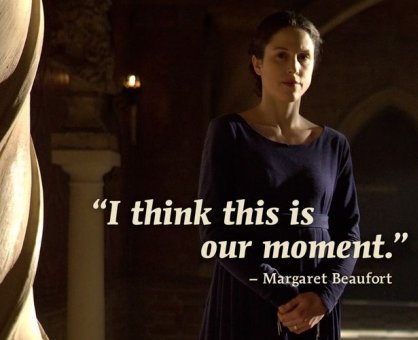 |
Following Edward IV's untimely death and the
subsequent seizure of the throne by Richard III,
both Stanley and Margaret changed their spots
brilliantly. Lord Stanley, a cynical man, made
sure to be one of the first to shake Richard's hand.
Later Lord Stanley bore the great mace at Richard's
coronation.
In turn,
Margaret played her part to perfection. She
too was full of smiles and
congratulations. Indeed, Margaret
played a leading part
in the coronation of Richard III
by
being the first to offer to
serve Anne Neville. Smart move. Margaret
was given the honor of carrying Anne's
train at Richard's coronation.
However this
time Margaret's friendship was two-faced. She
knew her moment had come. Stanley did too.
"Well,
Margaret, I never should have doubted you about your
son.
Indeed, the game is afoot. Let's see what
happens."
Sure enough, while appearing
to loyally serve Richard and Anne, the new king and
queen, Margaret was secretly plotting with the
dowager queen, Elizabeth Woodville.
|
| |
|
Mainstream Versus
Creativity
|
|
|
|
Rick Archer's Note:
Few subjects hold more
interest to the English people than the question of
what happened to the Princes in the Tower.
For American citizens, the question of who
assassinated President Kennedy is a close
approximation to the amount of mystery surrounding
this event.
Keep in
mind that we don't know if the princes were murdered
or simply whisked away to Transylvania and never
heard of again. It is also important to note
that few documents exist to offer clear-cut clues as
to the fate of these two boys. Therefore the
historians have worked overtime trying to come up
the answer.
The
Mainstream theory is that Richard disposed of the
boys. I have found an excellent author named
Matthew Lewis to defend this point of view.
The Creative theory is that Margaret Beaufort did
it, a point of view best defended by an excellent
author named Philippa Gregory espouses this point of
view.
Please
understand that I respect the thoughts of both.
I present the ideas of both authors simply to allow
the reader to join the interesting debate.
|
 |
| |
|
Matthew Lewis
The
importance of the vanished Princes in the Tower
cannot be emphasized enough. Back in the 15th
century, in the court of
public opinion, it was judged to be an unusually
cruel move for Richard III to usurp the throne by
murdering his dead brother's innocent and quite
helpless sons.
But did
Richard really murder those boys? The question
has been heavily debated for six centuries. In
fact, I am surprised that an English version of a
the board game Clue has not been
invented with a Princes in the Tower theme.
In
addition to Richard, other murder suspects include a
low-life agent hired by Margaret Beaufort, Lord
Stanley himself, the Duke of Buckingham, a low-life
agent hired by Anne Neville, and even Henry Tudor
after he took the throne.
|
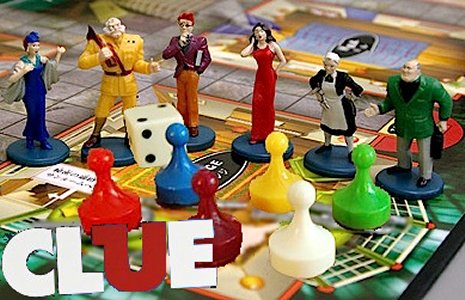 |
| |
|
What we
do
know is that the disappearance
of the Princes in the Tower was seemingly a glaring political
mistake on Richard's part because it was an
unforgivable act. History shows that the
disappearance of these boys was the break of a
lifetime for Margaret. She was able to muster
considerable support for the overthrow of Richard
III based on what people believed was the blatant
cold-blooded murder of the two boys.
What is
interesting, however, is just how much Margaret stood to gain
from Richard's blunder. In fact, Margaret
stood to gain so much that people have long wondered
if Margaret did the deed herself, then turned around
and pointed her
finger at Richard.
Was it even possible?
Yes,
according to author Matthew Lewis, it
was.
In his
book Wars of the Roses, Mr. Lewis
supports the mainstream idea that Richard was the
likely culprit. However, in his blog, Mr.
Lewis also agrees the possibility that Margaret did
the crime is not entirely implausible. Those
who automatically eliminate Margaret from suspicion
are being ridiculous. I have synthesized Mr.
Lewis' ideas below, but you are welcome to read for
yourself what Mr. Lewis has to say online:
Matt's History Blog
~ Hopefully interesting snippets and
thoughts regarding Margaret Beaufort and the
Princes in the Tower
"The White Queen series (based on books
by Philippa Gregory) stirred up the latent and
under-examined but long-standing theory linking
Margaret Beaufort to the disappearance and
murder of the Princes in the Tower. In
short order, the increased attention drew an
onslaught of opinion denouncing the theory as
impossible, implausible nonsense.
My point here is that all of those who sneer at
the notion that Margaret Beaufort could have
been involved are, in my opinion, wrong.
Margaret had motive, means and opportunity, and
that makes her a suspect."
|
| |
|
Here is
my summary of what Mr. Lewis proceed to say about
Margaret's possible involvement.
In the summer of 1483 Lord and Lady Stanley
were riding high in royal favor. Since they
had done nothing to
attract suspicion, they had easy access
to the Tower. We think of the Tower of London as a
prison, but it was more like a royal office building back in those
days. The boys were not in some dungeon, but
rather a comfortable royal suite (with locked
doors). Since the Tower was a very busy place, regular comings and goings for people of such
influence as Lady Stanley or Lord Stanley would not necessarily be
noticed. Therefore, 'Opportunity' was
surely within their reach.
Considering Margaret had the reputation as the most
pious woman in England, a cold-blooded assassination would certainly be
considered a major departure from character. That
said, Margaret had Motive (her son's
advancement),
Means (Lord Stanley), and Opportunity.
This
doesn't mean Margaret committed the crime, but
it does mean that
Margaret was a viable suspect. Therefore
Ms. Gregory's alternative scenario with Margaret
as the villain to Richard as the villain is not
as far-fetched as people believe.
There is a clear
evidence that Margaret
Beaufort immediately went to
work plotting Richard's
downfall shortly after
his coronation. The moment people began
to openly wonder why the boys had not been seen in a
while, it seems likely that Margaret opened up a clandestine
line of communication to Elizabeth Woodville
holed up in sanctuary at
Westminster Abbey.
Margaret
used her physician Lewis Caerleon, who posed as
Elizabeth’s physician, to pass messages between the
two women.
Most
historians agree that at this time Margaret
proposed that her son, Henry Tudor, be betrothed to
Elizabeth of York, eldest daughter of Queen
Elizabeth and Edward IV. On the surface, this was brilliant
politics because it had to potential to create a
marriage alliance which would attract both Yorkist
and Lancastrian support.
Where is
Sherlock Holmes when we need him??
|
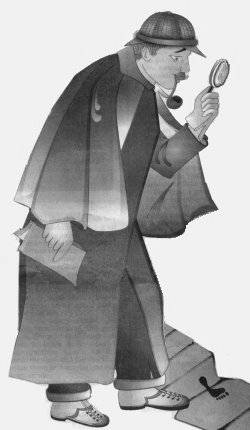 |
| |
|
While
Mr. Lewis agrees with Ms. Gregory that Margaret may
indeed have been far more complicit in the crime
than most historians believe, in his book War
of the Roses, he accepts the Mainstream
Scenario that Richard was the culprit.
Mr.
Lewis makes the following points:
•
The idea that Margaret
spent her whole life dreaming of putting Henry
on the throne was far-fetched. More likely
her ambition took hold thanks to the curious
events of Edward the King dying young and his
unscrupulous brother Richard taking over.
•
Elizabeth would never
have agreed to marry her daughter to Henry Tudor
unless she was convinced her two boys
had been murdered. The likelihood that her
sons were indeed dead is what persuaded
Elizabeth to agree to marry her daughter
Elizabeth of York to Henry Tudor.
•
Therefore, Margaret
must have somehow convinced Elizabeth that the
boys were gone. If this is the case,
then how did
Margaret know the boys were dead?
•
Mr. Lewis answered
his own question by saying that Margaret did not
know, but had the sense to gamble and lie to
Elizabeth about it.
Please
read the excerpt below written by Matthew Lewis.
|
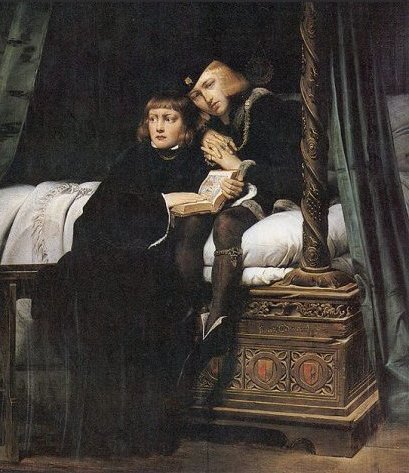 |
| |
|
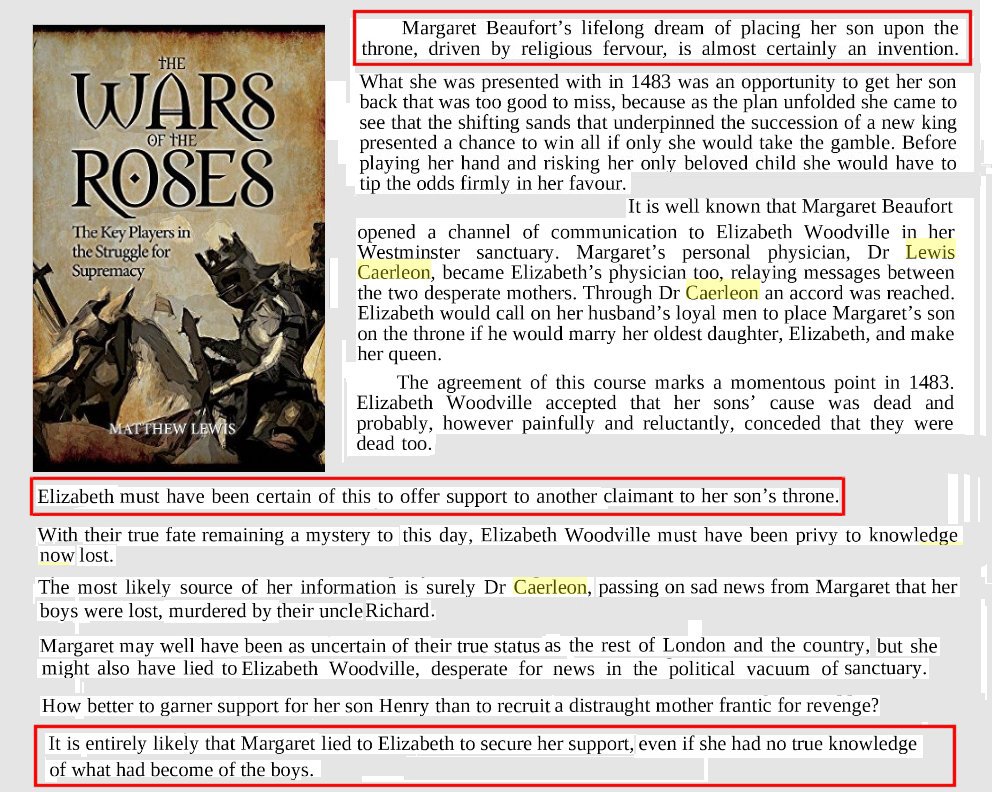 |
 |
| |
The Creativity
of Philippa Gregory
|
| |
 |
| |
The
White Queen mini-series was
adapted from a trilogy titled The Cousin's War.
In Episode 9,
author Philippa Gregory made it clear she believed
Margaret, not Richard, was responsible for the death of
Elizabeth Woodville's two princes in the Tower.
In an
early scene, Lord Stanley confronts Margaret
Beaufort, his wife. Stanley gets right to the
point.
“What do you want to do
about the two boys? Save or slaughter?”
When
Margaret gets a pained, doubtful look on her face,
Stanley is not delicate about it. He
points out the necessity of their deaths.
However he also leaves the final decision up to his
wife.
When
Margaret continues to hesitate, Lord Stanley demands
of her harshly. “As I said, save or slaughter?”
With a
nod, Margaret
finally agrees the two boys have to go.
Soon we
see a hooded figure creep into the boy's room in the
Tower and smother them to death with a pillow.
This was not Richard's idea after all, but rather an
idea shared by Margaret, Stanley, and Buckingham as
part of their rebellion plot.
|
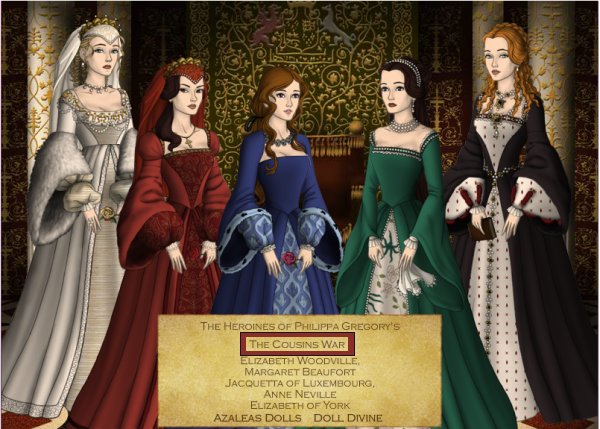 |
| |
 |
| |
First
Margaret sends her doctor to explain to Elizabeth
that the two boys are in great danger.
Elizabeth, fearing for the boys' safety, accepts an
offer of help to rescue them by Margaret, whose son
Henry is now betrothed to Elizabeth's daughter
Lizzie.
However
something goes badly awry with the rescue/murder
attempt. Somehow the boys end up dead on a
further try. Margaret sends the doctor back
over with the bad news. Learning that her boys
are dead, Elizabeth believes that she was
double-crossed by Margaret in the Red Queen's
ambition to see Henry crowned king.
When
Elizabeth hears the news of her sons' death, she is
overcome with grief. And not just ordinary
grief, but rather the profound grief of a mother who
truly cares about her children. Suspecting that Margaret is behind this,
Elizabeth vows to get even.
A week
or so passes when Elizabeth hears there is
rebellion about to take place against Richard.
This entire operation is being planned and funded by
Margaret. Elizabeth also learns that a major
part of the plan involves Henry's return to England
by crossing the English Channel. Margaret's son Henry is supposed to sail with seven
ships from France over to England to participate in
the wide-spread uprising. If the plot
succeeds, Henry will take the throne.
Elizabeth is determined to foil this rebellion, but
she has a problem... she is still stuck inside the sanctuary at
Westminster Abbey with her twenty daughters (or
maybe it was just seven; I lost count).
So here
is the question: How does a mother tyically foil a rebellion while stuck in a
virtual prison of sorts?
C'mon,
now, I know a lot of you out there are mothers.
Surely this qualifies you to know exactly what the
average mother would do to seek vengeance in a
situation like this. Well, just in case you
come up empty, I will share with you what
author Philippa Gregory suggested
Elizabeth did.
Ms. Gregory
had previously told us that Elizabeth inherited the
power of sorcery from her mother Jacquetta.
Furthermore, while trapped in the Abbey, Elizabeth
had just viewed Walt Disney's Fantasia.
Think about it... what does a mother with twenty
daughters do when everyone is cooped up at home?
She gets out a video and the family watches the
telly, of course.
Fantasia gave Elizabeth an idea.
The next thing we see is that Margaret and her
kinsman Buckingham have instigated a large-scale
rebellion against Richard, but rebellion fails
miserably. And why does the Rebellion fail?
There is
a storm. And not a natural storm either, but
rather the storm of all storms.
|
 |
It
is almost as if 'Fate' or God has intervened
to foil the rebellion. The storm completely
ruined the rebellion, but then we discover this is
Elizabeth's doing.
Using
the magic words 'Mickey Mouse',
Elizabeth has created the
biggest, baddest damn storm in human history.
Birmingham was unable to cross rivers because the
bridges are washed out. Henry was unable to
leave France because the storm is too great.
The rebellion collapsed.
|
 |
Indeed,
Elizabeth's sorcery ruined Margaret's grandiose
scheme. Elizabeth had her vengeance.
So did
it really happen this way? Uh, maybe not.
I have a confession to make... I did some fibbing involved in the retelling of
Episode Nine. That part about Mickey Mouse was just some
nonsense I made up. But you already
guessed that, didn't you?
And what
about that big storm? No, I didn't make that
one up. That was Ms. Gregory's idea. She had
Elizabeth Woodville wrinkle her nose a couple times
and magically create the mother of all storms to
frustrate Buckingham's rebellion and foil Margaret's
dreams.
|
| |
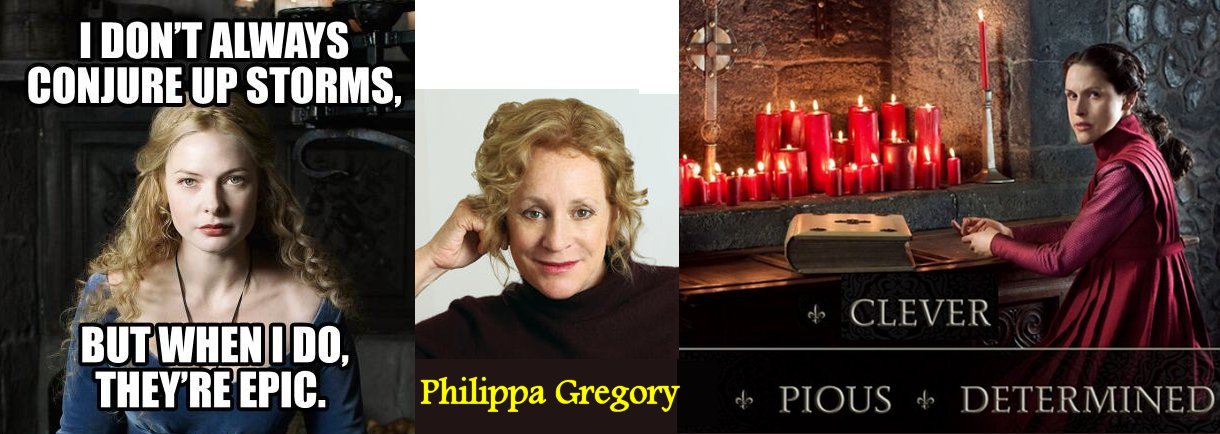 |
One
reviewer of the White Queen had this to say about
White Queen Episode Nine:
"Philippa
Gregory’s project - and so that of her White
Queen series - was to tell a ripping yarn whilst
refocusing history’s lens on the women whose
political and emotional lives were buried
beneath their official portraits and lists of
issue."
Ripping
yarn?? That may be a bit of an understatemnt.
I do not
know Ms. Gregory personally, but I suspect she has
used her imagination a bit in this retelling.
My hunch
is this prolific, best-selling author did not
achieve her phenomenal success by playing it safe. In fact, I believe
when given the choice, Ms. Gregory has made a habit
of deliberately choosing the most entertaining
option over the more mundane possibilities.
And why not? No one really knows what happened
six hundred years ago.
As we
know,
England has an impressive legacy of stretching
things a bit. Witness the King Arthur
mythology... Camelot, Holy Grail, Sword in the
Stone, Guinevere, Lancelot, Galahad, Merlin... you
name it. But guess what? (WARNING-
SPOILER ALERT!!)
(Did you
know some people believe all that King
Arthur stuff was made up? Have you ever heard
anything more ridiculous?)
And then there was that
nonsense about what a great king Richard the
Lionheart was... And then there was that crazy
story about Robin Hood and Maid Maiden, etc, etc,
etc.
And... get
this... some people have the nerve to say that William Shakespeare made
some things up. Yes, it's true! In a
manner similar to William Shakespeare, I think there
are moments when a master yarn-teller such as Ms.
Gregory would not dream of letting the truth get in
the way of a good story. If
perchance Ms. Gregory used her imagination from time
to time in telling the White Queen story, then who
am I to quibble? I daresay Ms. Gregory did not
become a best-selling author by accident.
|
 |
 |
For
example, Ms. Gregory makes frequent use of
Elizabeth's knack for sorcery. The fact of the
matter is that I would be perfectly happy to let the
sorcery of the White Queen explain all sorts of
weird phenomena such as the Bermuda Triangle and the
Lost Continent of Atlantis. I can be very
open-minded. In fact, maybe this would be a
good time to confess I have written
two books explaining why I believe in Fate. (A
Simple Act of Kindness,
Destiny)
Unfortunately, despite my unapologetic embrace of
all things Occult, the story of Hurricane Elizabeth
was too implausible for even me to accept. My
built-in bullshit detector was having fits.
On the
other hand, I would prefer not to cross literary
swords with the brilliant Philippa Gregory.
Since Ms. Gregory clearly knows more about this
story than I can ever hope to know, I hope she
doesn't take umbrage at my temerity to suggest a
potential over-reach.
Let's
put the debate over the big storm aside and
concentrate instead on Ms. Gregory's claim that Margaret
was responsible for the death of the two
boys.
According to Philippa
Gregory, Margaret Beaufort had the
strongest motive
to eliminate the two boys.
Ms. Gregory pointed out that the death
of the two boys allowed her son Henry
Tudor to advance Two
Steps closer to the throne.
Two steps, eh?? Aha, now
this is a subject I am qualified to comment on!
Being a
dance teacher from Texas, I happen to be an expert at the Texas
Two Step. I say that gives me the right to offer my opinion on the Tower
Two Step as well. Personally, considering how religious Margaret was,
my gut feeling is a murder of this nature would
go too far against her conscience.
When it
came to religion, Margaret was on par with the Pope
for intensity. Although it is true that Margaret was
at times fanatical in
her support of Henry, based on the woman I saw
portrayed on the White Queen and in
the journals, I think Margaret deserves the benefit of the
doubt on this one.
I am
with Gareth Streeter of
Royal History Geeks on this one:
Margaret was not a sinister child killer. I am
not saying Margaret was perfect, but she was more
likely to pray for something to happen than to
sanction a hit.
To me,
Richard III makes a heck of a lot more sense.
Shakespeare thought so too.
"
|
Richard was the one with the reputation for
ruthlessness, not Margaret. He had ordered
several battlefield executions such as the beheading of Edward of
Westminster at Tewkesbury. He was likely
present in the Tower to help his brother Edward suffocate old
King Henry VI. Richard had persuaded his
brother Edward to put George to death. Richard
had sanctioned the cold-blooded murder of Elizabeth
Woodville's beloved brother Anthony Woodville and
her son Richard Grey.
Richard had assassinated Lord Hastings, the man who
had been the most loyal supporter of the York cause
imaginable. Richard had blatantly kidnapped
two boys and held them against their will.
How much
more evidence of Richard's cold-blooded nature do we
need? Richard
was past the point of rescue. Since Richard had already murdered
several innocent men to eliminate threats to his
rule, what difference would it make to murder two
boys if it would clear the way for his crown??
After all, Richard's place in Hell was already
assured.
Yes, the
history is very murky here. How did Margaret
manage to persuade Elizabeth to the union of Henry
Tudor to Elizabeth of York? My guess is that
both women independently reached the
same
conclusion as the other.
So when
Margaret's doctor brought up the possibility of foul
pay, Elizabeth was already in agreement. If
Elizabeth did have a gift of sorts, no doubt her
sixth sense had told her to brace for the worst.
Here is
the bottom line: Elizabeth agreed to
collaborate with Margaret and let her daughter marry
Henry Tudor. Give this cooperation,
it makes little sense that Elizabeth would create a
storm designed to destroy Henry Tudor, then turn
around and agree to let him marry her daughter.
It makes much more sense that Elizabeth agreed with
Margaret that Richard was guilty of foul play in the
first place.
Richard
had kidnapped Edward and Richard to begin with and
refused to allow them to be freed or be visited.
That put the blame squarely on Richard.
Therefore it makes complete sense for the two women
to team up against a common enemy.
Unless the boys made a miraculous reappearance, the
women
would work together to promote Henry Tudor’s
prospects of taking the throne.
The two
women had made an unbelievable bargain.
|
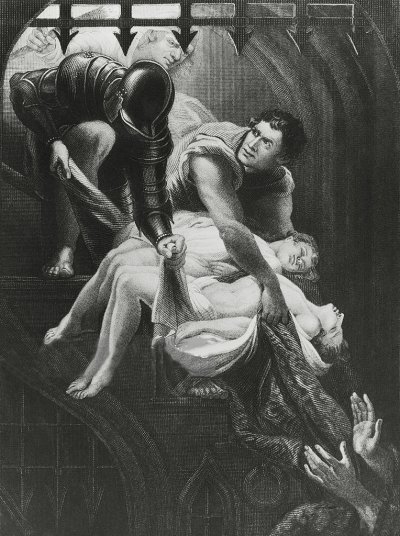 |
| |
Postscript: After giving it some more
thought, no, I still don't think Margaret did it.
But I wouldn't put it past Lord Stanley to do it
behind Margaret's back. That said, I have yet
to find a credible source that points the finger at
him.
In
addition, Mr. Streeter had this to say about Lord
Stanley:
"The Croyland Chronicle (c. 1486) and the
account of Dominic Mancini (the only
contemporary account) are important.
Collectively these documents give us a fair bit
of information about how the Princes were drawn
further deeper into the tower. They make
the case that all but Richard's closest and most
trusted servants were dismissed and denied
access to them.
It is this knowledge that is at the heart of the
compelling - although circumstantial - evidence
that the poor lads could only have been killed
on Richard's orders or at the very least, he
would soon have found out about it.
To me, it seems strange that if Stanley had done
the deed, that Richard would not have been able
to trace it back to him. Exposing the killer
would have done Richard a favour - he could make
it clear that the boys were dead but also that
he was blameless. Such a scenario would probably
have meant the Tudors never came to power."
Concerning the mystery of the Princes in the Tower,
I also found a remarkable web site that helps clarify
the murder case. A man by the name of Mick
Baker has synthesized an incredible
amount of research into a remarkably comprehensible
flow chart. I am in awe of Mr. Baker's work.
(Source:
History Files)
|
| |

|
| |
Henry
Stafford, the 2nd Duke of Buckingham, led a
rebellion in mid
October 1483, just four months after Richard's coronation.
Stafford had been Richard’s closest ally over the
last few months, so no one is quite sure why
Stafford turned against his partner in crime.
Stafford
was one of the primary suspects in the disappearance
(and presumed murder) of the Princes in the Tower.
Most people assume that Buckingham and Richard acted
together in the death of the boys.
Considering Buckingham was basically the 'Vice-President',
or 'president of vice' if you prefer, it is
surprising that he turned around and led a
rebellion. Perhaps the death of the two boys
triggered Stafford's rebellion. In the
same manner as all the male Lancasters had been
eliminated, now that the two princes were gone,
Stafford (Buckingham), Richard III
and Henry Tudor were the only surviving male heirs
to the House of Plantagenet.
The reasons why
Buckingham led a rebellion against Richard are not
clear but several possibilities can be considered.
First, Buckingham had just as legitimate a claim to the throne as
Richard. Gauging by popular dissatisfaction with
the new king, Buckingham might feel he should take his
chances and set himself up as the rival claimant
(particularly since Edward V and Richard of York
were supposedly murdered). Second, as a rival
claimant, Buckingham undoubtedly felt uneasy about
his own safety. Knowing Richard's penchant for
murder and that he was a potential rival, it was
possible he would decide to murder Buckingham as
well. As in all the gangster movies, the thug
who hits first usually comes out on top.
Assuming that Buckingham suspected his own life
was forfeit with Richard III, he decided to team up
with Henry Tudor to eliminate Richard. He and
Tudor
could sort out things once Richard was defeated.
This
particular explanation is explained well in
William Shakespeare's Richard III.
|
| |
|
Synopsis of Shakespeare's
Richard III:
Act IV, scene 2
Back in the palace, the gloating Richard, the
recently crowned king of England, enters in triumph
with Buckingham and Catesby.
Richard announces that he does not yet feel secure in his
position of power. He tells Buckingham that he wants
the two young princes, the rightful heirs to the
throne, to be murdered in the tower.
To murder innocent children is a serious crime.
For the first time, Buckingham does not obey Richard
immediately. He hesitates and says he needs
more time to think about the request.
Disgusted, Richard murmurs to himself that
Buckingham is too weak to continue to be his
right-hand man. Instead he summons a lowlife
named Tyrrell who is more than willing to accept the
mission.
In almost the same breath, Richard instructs Catesby
to begin spreading the rumor that Queen Anne Neville is sick.
Tell everyone she is likely to die. Then
Richard gives orders to keep the
queen confined. That accomplished, Richard
turns to the
audience and announces his intention to marry the
fetching Elizabeth of York, daughter of the late King
Edward. The
implication is that Richard plans to murder Queen Anne at
the first convenient moment.
Buckingham, uneasy about his future, suggests it is
time for Richard to give him earldom of Hereford as
Richard has promised earlier. Richard angrily
rejects Buckingham’s demands and walks out on him.
Buckingham, left alone, realizes he has fallen
out of Richard’s favor. He decides to flee to
his family home in Wales before he meets the same ill
fate of Richard’s other enemies...
|
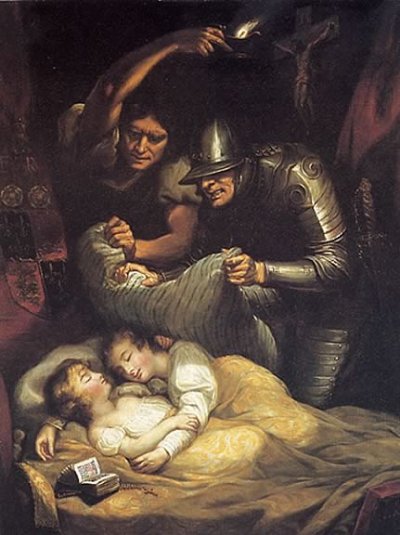 |
|
|
|
If we
can believe Shakespeare's explanation (and many do),
after leaving London, the Duke of Buckingham paid
Margaret Beaufort a visit. Keep in mind there
were two 'Henry Staffords' in Margaret's
life. One was her deceased husband Henry
Stafford who died in 1471 of injuries suffered at
Tewkesbury. The other was her nephew Henry
Stafford, the son of Humphrey Stafford, brother to
her deceased husband. This is who came to
visit.
Margaret's sense of opportunism led
her to support Buckingham's
daring autumn rebellion of 1483.
Here
she plotted to unite York and Lancaster factions in
a risky scheme to bring her son to the throne.
One part of the plan
had the exiled Henry Tudor
bring seven ships over from Brittany carrying 500
well-armed Breton soldiers
and Lancastrian followers.
In
retrospect, the timing was probably premature.
Although Richard was unpopular, the rumors of his
treacherous deeds had not quite spread to the
population at large. Consequently this
rebellion did not have strong support. Nor did
it have good luck.
Right from the start there
was trouble. Buckingham was not exactly a
charmer. His Welsh army decided they
liked him less than Richard III. Loyalty was
an immediate problem.
Then a
ten-day gale ended their dream
completely.
Due to a tremendous storm which battered England,
the Severn River became swollen and
ferocious, bursting its banks at many points. With
bridges unusable, Buckingham could find no crossing.
Seeing this fight had no chance of working,
Buckingham's men men deserted him.
Meanwhile, out in the English,
Channel,
Henry Tudor’s fleet had been scattered by the same
storm. However
Henry's
ship managed to get close enough to land.
Henry decided to risk coming ashore alone
and have a look around. As he rowed to shore,
Henry was hailed by a
group of soldiers on the beach as a victorious conqueror.
Henry stopped rowing so he could discuss his 'Victory'. The
men on shore assured Henry that
Buckingham had succeeded.
Henry
sensed a trap.
In the driving rain, it was too difficult for Henry to believe
this attack had any chance of success. Henry turned his
boat around and went back to the
ship, then went back to Brittany. His
caution doubtless saved his life.
Henry Stafford did not fare as well. A reward
was posted and someone turned him in. Stafford
was beheaded in a well-attended public execution.
The rebellion was over.
Margaret
Beaufort was cornered.
Always the schemer, Margaret had stayed above board
till now. This time her fingerprints were all over
this plot. It was clear she had bankrolled
this rebellion using her vast wealth. Richard
strongly considered executing her for treason.
Lord
Stanley's odd role in the rebellion is probably what
saved his wife's life. Curiously, when Richard
learned of the rebellion, Lord Stanley and his brother
William answered the call immediately and remained at the King's side throughout.
The
brothers were richly rewarded from the forfeited estates
of the rebels. Lord Stanley was appointed to
Buckingham’s former position as Lord High Constable
of England and William Stanley was made Chief
Justice of North Wales.
No one is quite sure why Stanley
remained loyal to Richard in these circumstances.
After all, months earlier Richard had killed Stanley's
friend Lord Hastings and threatened to do the same
to Stanley. Considering Stanley's wife had
planned this uprising, why did Stanley's loyalty lie
with his king over his own wife?
In the
end, Thomas Stanley's loyalty was a huge break for
Margaret. It was only by Stanley giving a solemn vow to Richard
to keep his wife in custody and put an end to her intrigues
that saved her from attainder, disgrace, and quite
possibly imprisonment... or worse.
Although Richard did confiscate her holdings, he turned
around and gave them to her husband Stanley instead.
In other words, the money was still in the family.
Richard’s lenient response was surprising.
Considering Richard was said to be a merciless,
ruthless tyrant, Margaret was in effect let off
with a wrist slap. Yes, her lands were forfeited,
but as long they remained in the household, big deal. Margaret was placed under
house arrest in her husband’s care. Stanley
promised to make sure that she made no contact with her
son, but this arrangement, of course, was sheer
nonsense.
Richard counted on Stanley
being more loyal to him than to his own determined
wife. If he knew just how passionate Margaret
was about putting her son on the throne, he should
have executed her just like he did Henry Stafford. Richard’s mercy, and perhaps naivety, would come
back to haunt him. Beheading women would have
to wait for the Tudor era.
|
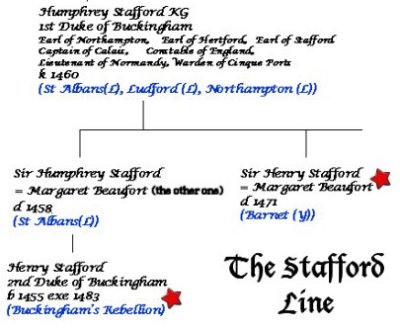
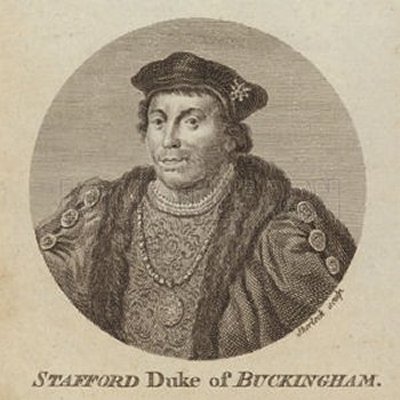
 |
Death in the Royal
Family
|
This was an
age when there was great interest in the occult. Witches were
real and women
were often accused of sorcery. Anything out of
the ordinary was instantly assumed to be an omen of
some sort.
As omens
go, Richard
III had pointed to his successful suppression of the
Buckingham Rebellion as clear evidence that God really did want
him to be King. But then something happened that
shook Richard to his core.
Edward
of Middleham was born to King Richard and Anne
Neville in 1474.
Edward was created Prince of Wales in September
1483, then was formally declared heir apparent
in February 1484. Two months later the boy was
dead. Edward had been a sickly boy his entire
life. Nevertheless, the
swiftness of his death
was
very upsetting. There was no obvious reason.
It was a
bad omen to be sure.
Richard's enemies spread rumors saying
that Edward's sudden death was divine retribution.
This was surely God's payback for Richard's alleged involvement
in the evil disappearance of
the sons of Edward IV, the erstwhile Princes in the
Tower. If
Richard was feeling guilty about their death, this incident
with his own son did
not help.
|
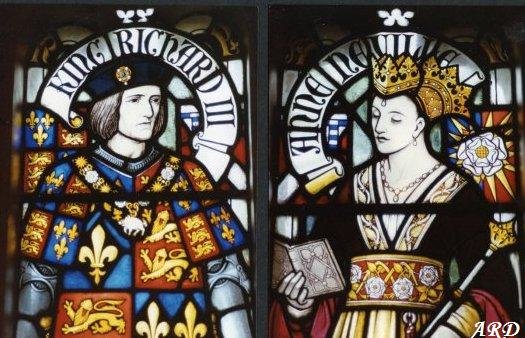 |
Anne
Neville, the boy's mother, fell gravely ill only a
few months after her son's death. She died on
16 March 1485, 11 months after her child. The
official reason is listed as tuberculosis.
Others say it was a broken heart at the loss of her
child.
And then
of course there were the rumors. On the day
Anne died, there was a solar eclipse. This was
taken to be an omen of her husband's fall from
heavenly grace. Another rumor circulated
that Richard III had poisoned his wife in order to
marry his beautiful niece Elizabeth of York.
Shakespeare particularly liked this rumor. If
anyone has ever seen Richard III,
Shakespeare did not waste a single chance to paint
the darkest picture of Richard possible.
The
death of Richard's sad little boy put an exclamation point
on a strange coincidence. The War of the Roses
had been complicated by the death of King Edward.
During his reign,
three unhappy princes
named Edward had died. All three
had been the Prince of Wales,
all three were called Edward
and all three died young
before becoming King.
The
first Edward to die was Edward of Westminster, 'Joffrey'
so to speak. This Edward had died by execution
following the bitter defeat at Tewkesbury in 1471.
He was 17.
The
second Edward to die was Edward V, oldest son of
King Edward IV.
This Edward was one of the Princes in the Tower.
He disappeared at age 12 never to be seen again.
Most historians assume Edward was murdered by his
uncle Richard in pursuit of Edward V's birthright.
And now
Edward of Middleham, 10, was the third Prince to
die. Upon hearing the news,
Richard and Anne were seen convulsed in grief so
powerful it
bordered on madness.
Not that
it matters, but one hundred years earlier the Black
Prince became the first Prince of Wales not
to become King of England. The Black Prince died of a
mysterious lingering disease that was said to be his
punishment for murdering countless French victims
during the Hundred Year's War.
Upon his
death,
the throne passed to his son Richard II, considered
to be one of the worst kings in English history.
The reign of Richard II was so inept that he was
easily overthrown in the 1399
rebellion led by Henry Bolingbroke (Henry IV).
It was this 'Crown by right of might, not law'
that was said
to have set the stage for the subsequent War of the
Roses. From this point on, an ounce of royal
blood and a ton of cannons was all it took to be
English King, a scenario played out time and again
during the War of the Roses.
By the
way, does anyone remember the first name of the Black
Prince?
If
memory serves, it might have been Edward.
By the
way, the Black Prince had a son named Edward.
Whatever happened to him? Edward should have
been the next king but he died at the age of five,
leaving his three-year-old brother Richard II to
take his place. Weird.
|
|
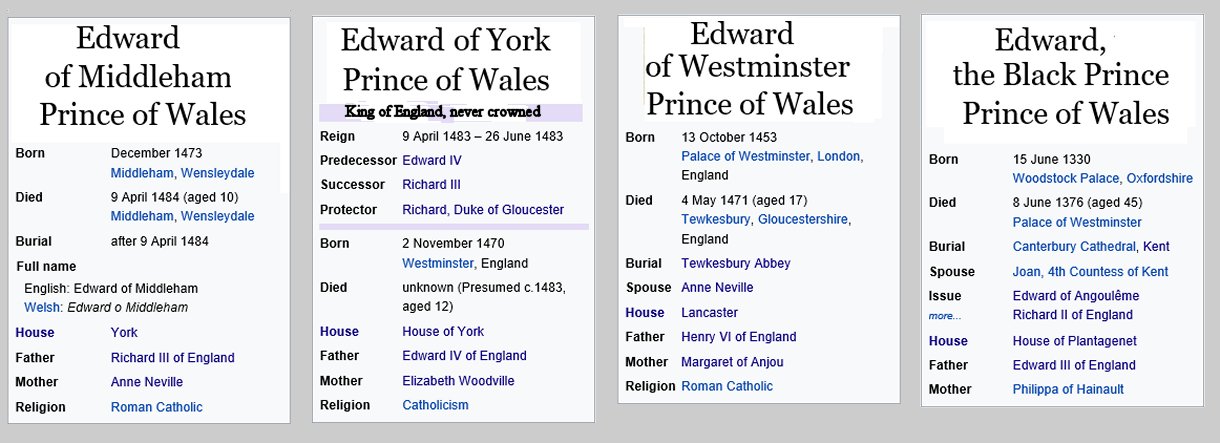 |
The Failed Invasion
Edward IV
had died of natural causes after a short illness in
1483. His brother Richard was supposed to
guard the throne till his nephew Edward V was old
enough to take over. Instead Richard took the
throne for himself. There was great anger in
the land at Richard over his likely murder of two
innocent, helpless boys. This was seen as a
heinous crime.
Margaret
Beaufort knew this foul deed was the opening she had
prayed for. She actively promoted her son as an
alternative to Richard III, despite being
married to a Yorkist, Lord Stanley.
Unfortunately, her first attempt at overthrowing
Richard, Buckingham's Rebellion in late 1483, had
failed miserably. Richard III claimed this was
proof that God wanted him to reign supreme.
Perhaps this belief made him over-confident because
he failed to execute Margaret when he had every
right do do so. That was a mistake that would
come back to haunt Richard.
Following the accession of Richard III, English
privateers were continually attacking Breton ships.
With
Duke Francis of Brittany fighting a prolonged illness,
in his
place stood Prime Minister and treasurer Pierre Landais. Irritated by the
loss of shipping, Pierre Landais initially attempted to appease
Richard III, but that didn't work.
So
Landais switched his support to Henry Tudor in
the hope that he would overthrow Richard. With
money and supplies borrowed from his host, Francis
II, Duke of Brittany, Henry had tried to land in
England, but the great storm caused his rebellion
to unravel. This resulted in
the 1483 execution of the Duke of Buckingham, nephew of
his mother and co-conspirator of Henry.
The Coming Storm
Two
years had passed since Henry had
escaped
back to Brittany.
It was now
1485. Unbeknownst to Henry Tudor, Richard III
had agreed to some skullduggery with Pierre Landais.
Still fuming over the aborted Buckingham Rebellion, Landais
strove to defend the independence of Brittany
against the machinations of Louis XI, the King of
France. He opened secret negotiations with
Richard III of England. As the main threat to
the rule of Richard, Henry Tudor was a powerful
bargaining chip.
Richard
III offered to send 4,000 English and
Welsh archers to help secure the power
of Landais against the rebel Breton nobility. In return, Landais
would arrange the capture and extradition
of Henry, Jasper Tudor, and the other
exiled Lancastrians. Landais readily agreed to
sell them out.
|
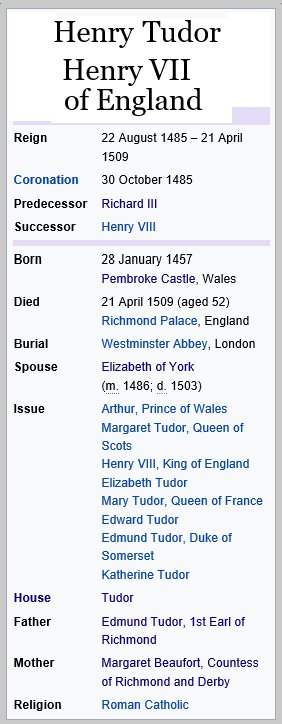 |
Landais assembled an
armed force in Rennes to march to Vannes and
capture all of the Lancastrians, 300 experienced
soldiers in all. At the last minute, someone
leaked news of the plot to Henry... quite possibly a
message from Lord Stanley. Facing
arrest and extradition to England, Henry and Jasper
found two horses and
fled across the nearby border into Anjou.
They crossed
only hours ahead of Landais' troops. The men
left behind were captured.
Henry
had escaped his third trap. As Henry rode
towards the French Royal Court, little did he know the treachery of Pierre Landais
would
backfire in his favor. Henry was welcomed by the French who
viewed both Richard III and Pierre Landais as their
enemy. The French were more than happy to supply
Henry with troops and equipment for a
second invasion of England. Better to have
un ami, a friend, on the English throne!
Where
have we heard this story before? Indeed, back
in 1471 Warwick and Margaret of Anjou had teamed up
to send Edward IV into exile and place Henry VI back
on the throne. Just when Margaret of Anjou
thought everything was secure, the Wheel of Fortune
swung back in the York's favor when the Earl
of Warwick made a serious blunder. Warwick was
pressured by the King of France to wage war against
France’s enemy the Duke of Burgundy, in exchange for
Marguerite of Anjou and her forces to be allowed to
journey to England. Once Warwick declared war
on the Duke of Burgundy, two bad things happened.
First, in retaliation, Burgundy
decided to supply his brother-in-law Edward IV with
ships, men, and money to jump-start his comeback.
Second, Margaret's delay prevented her from
reinforcing Warwick at Barnet. After Warwick's
death at Barnet, Margaret was vulnerable at
Tewkesbury. Had Warwick and Margaret of Anjou
been together, Edward would have never stood a
chance.
United
we stand, divided we fall.
Too bad Edward
had to die young. C'est la vie.
It was now 1485 and the French were ready to meddle again.
During
his two-year reign, Richard III had made many
enemies. That included the
French who were dying to strike back.
Henry was the lucky recipient. His close call with
Pierre Landais was a different kind of omen.
It suggested his mother's dream was coming to pass. Henry
was gaining support from many other corners as well. Henry
knew he had solid Lancastrian backing
at home. Indeed, the remnants of the
Lancaster court
were more than ready to support Henry.
Previously he had been a relatively unknown scion
of the Beaufort family, but given a second
chance after Buckingham's Rebellion, the Lancasters
knew Henry was a bold outlaw who deserved their
backing against Richard.
In
addition to the much-needed backing of the French,
Henry enjoyed another wonderful gift when he was reunited
with John de Vere. John de Vere, also known as the Lord of Oxford,
had almost been the Lancaster hero of the 1471 Battle of
Barnet, but became the goat instead.
After losing control of his men who stopped fighting
to pillage the town of Barnet after routing the men
of Lord Hastings, Oxford had the misfortune of being
mistaken for the enemy when he and 800 men returned
to the battlefront.
Imagine
how Oxford felt. The mistaken identity was not
really his fault, but many blamed him nevertheless.
His mistake had been costly. Warwick was dead.
Margaret of Anjou was gone and her nasty son Edward
was dead. All the Lancaster men were dead and
the cause had been in suspended animation for the
past fourteen years.
Life had
not gone well for Oxford since. In the years
following, his lands had been confiscated. As
an outlaw,
Oxford had gone to France. He had spent over
ten years fighting as a mercenary in France
and studying French military tactics. Making
matters worse, Oxford had gotten himself caught.
Imprisoned
at Hammes Castle near Calais, Richard
had just sent the order to bring Oxford back to England for execution.
However,
before the transfer could be effected, Oxford was
able to persuade Sir James Blount, captain of the
prison, to change sides and oppose Richard instead.
Oxford escaped along with Blount to join
Henry Tudor in Paris. Understandably, this upset
Richard no end. The
Oxford episode was indicative of the growing lack of loyalty to
his
regime.
Lost in
the shuffle were the footprints of Lord Stanley.
A writer named Jean Molinet claims Lord Stanley
worked behind the scenes to engineer the defection
of the Hammes captain.
|
| |
|
Blount and
Oxford immediately left Calais to reunite with Henry
Tudor. Henry was said to be "ravished with
joy incredible" at this surprise. Oxford
immediately returned to Hammes Castle to liberate
the garrison there. A hundred imprisoned
Lancastrians were freed to come join Henry's fight.
Blount's
defection was a good sign indeed. It suggested
Henry had a great deal of support came from the Yorkists themselves. Richard III
was a
York, but he was the wrong York. Everyone
preferred the Old York over the New York.
Legions of disgruntled
supporters of dead King Edward were still
furious about Richard's unlawful seizure of the
throne.
Here is where Margaret's master stroke
had paid off.
Thanks to
the secret negotiations between Margaret and
Elizabeth Woodville, the two mothers had made the
deal of a lifetime. Elizabeth's daughter,
Elizabeth of York, was quite the prize. She
was not only beautiful, Elizabeth had royal blood in
her.
Indeed,
at Rennes Cathedral
in France on Christmas Day 1483, Henry publicly pledged to marry Elizabeth
of York, the eldest daughter of Edward IV.
Elizabeth
of York was the heir of King Edward IV due to the presumed death of her
brothers in the Tower. Elizabeth served as a
powerful reminder of the good old days of her father to many
people.
By
pledging Elizabeth, dowager queen Elizabeth
Woodville's lovely daughter, to Margaret
Beaufort's strapping Henry Tudor, this unusual
alliance of a York Princess to a Lancaster Prince
held great promise for peace.
Now all they had to
do was get rid of their unpopular king.
|
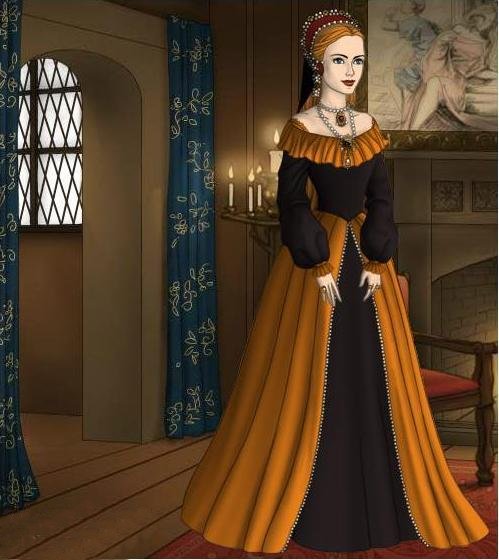 |
| |
|
| |
|
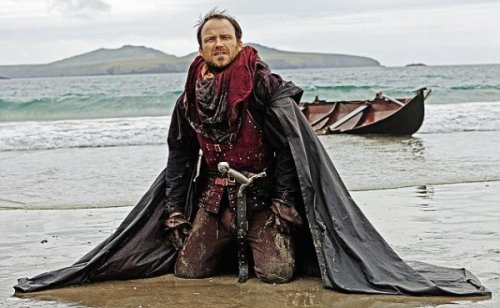 |
In 1399, Henry
Bolingbroke had returned from exile to depose unpopular King
Richard II.
In 1471, Edward IV had returned from exile to
reclaim his throne from the usurper Warwick.
In 1485,
it was up to Henry Tudor. The day had come for
Henry's return from exile to claim the English
throne.
On
August 1, Henry left Honfleur, France. He
sailed with a contingent of French mercenaries and
English exiles. The last time Henry had left
France, the Wheel of Fortune had frowned. What
would happen this time??
Henry
landed in Mill Bay, Pembrokeshire, a spot in Wales
close to his birthplace. It was the first time
in 14 years since he had been on English soil. Upon landing, Henry
knelt down and whispered, ‘Judge me, Lord, and
fight my cause.’
|
 |
Jasper
suggested Wales was the perfect place for invasion
since it was always hostile to the English monarchy.
Indeed, Henry's
Welsh parentage stood him in good stead.
Through his father Edmund Tudor, Henry was a direct
descendant from Lord Rhys, a famous Welsh ruler.
Henry's firm relationship with the popular Jasper
Tudor helped as well. Jasper was a national
hero – a Welshman who had succeeded at the English
court and could be counted upon to support their
rights. The Welsh were understandably
sympathetic to any cause which involved this
high-ranking Welshman. Henry Tudor amassed an
army of around 5,000 soldiers
Henry marched towards England accompanied by his
uncle Jasper and John de Vere, the Earl of Oxford.
Richard was waiting for them in the center of the
country. Reports came to Henry that Richard
was very well prepared. Things did not
look good for Henry Tudor. Not only was he
outnumbered 2 to 1, his opponent was a very experienced
commander.
Henry? He had never fought a battle.
Fortunately, he had Jasper and Lord Oxford at his
side.
The Wheel of Fortune was spinning.
|
|

















































































